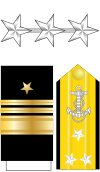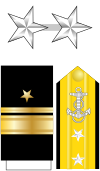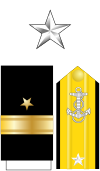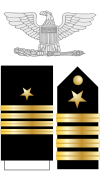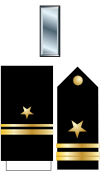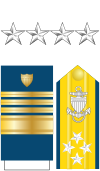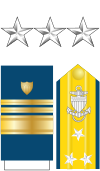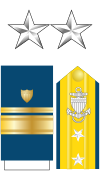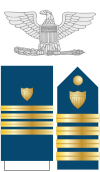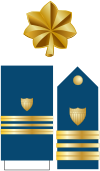Вооруженные силы США
Эту статью необходимо обновить . Причина: См. раздел «Персонал» . ( июнь 2024 г. ) |
— Вооруженные силы США вооруженные силы США это . [14] Вооруженные силы состоят из шести родов войск : армия , корпус морской пехоты , военно-морской флот , военно-воздушные силы , космические силы и береговая охрана . [15] [16] Все шесть вооруженных сил входят в число восьми силовых структур Соединенных Штатов , наряду с Уполномоченным корпусом Службы общественного здравоохранения США и Офицерским корпусом НОАА .
Each of the different military services is assigned a role and domain. The Army conducts land operations. The Navy and Marine Corps conduct maritime operations, the Marine Corps specializing in amphibious and maritime littoral operations primarily for supporting the Navy. The Air Force conducts air operations. The Space Force conducts space operations. The Coast Guard is unique in that it specializes in maritime operations and is also a law enforcement agency.[17][18]
From their inception during the American Revolutionary War, the U.S. Armed Forces have played a decisive role in the country's history. They helped forge a sense of national unity and identity through victories in the early-19th-century First and Second Barbary Wars. They played a critical role in the territorial evolution of the U.S., including the American Civil War. The National Security Act of 1947 created the modern U.S. military framework, establishing the National Military Establishment (later the Department of Defense or DoD) headed by the secretary of defense and creating both the U.S. Air Force and National Security Council; in 1949, an amendment to the act merged the cabinet-level departments of the Army, Navy, and Air Force into the DoD.[19]
The president of the U.S. is the commander-in-chief of the armed forces and forms military policy with the DoD and Department of Homeland Security (DHS), both federal executive departments, acting as the principal organs by which military policy is carried out.
The U.S. Armed Forces are one of the world's largest military forces in terms of personnel. They draw their personnel from a large pool of professional volunteers. The U.S. has used military conscription, but not since 1973. The Selective Service System retains the power to conscript males, requiring the registration of all male citizens and residents living in the U.S. between the ages of 18 and 25.
The U.S. Armed Forces are considered the world's most powerful military, especially since the end of the Cold War.[20] The military expenditure of the U.S. was US$916 billion in 2023, the highest in the world, accounting for 37% of the world's defense expenditures.[21] The U.S. Armed Forces has significant capabilities in both defense and power projection due to its large budget, resulting in advanced and powerful technologies which enable widespread deployment of the force around the world, including around 800 military bases outside the U.S.[22] The U.S. Air Force is the world's largest air force, followed by the U.S. Army Aviation Branch. The U.S. Naval Air Forces is the fourth-largest air arm in the world and is the largest naval aviation service, while U.S. Marine Corps Aviation is the world's seventh-largest air arm. The U.S. Navy is the world's largest navy by tonnage.[23] The U.S. Coast Guard is the world's 12th-largest maritime force.[24]
History
The history of the U.S. Armed Forces dates back to 14 June 1775, with the creation of the Continental Army, even before the Declaration of Independence marked the establishment of the United States.[25] The Continental Navy, established on 13 October 1775, and Continental Marines, established on 10 November 1775, were created in close succession by the Second Continental Congress in order to defend the new nation against the British Empire in the American Revolutionary War.[26][27]
These forces demobilized in 1784 after the Treaty of Paris ended the Revolutionary War. The Congress of the Confederation created the current United States Army on 3 June 1784.[25] The United States Congress created the current United States Navy on 27 March 1794 and the current United States Marine Corps on 11 July 1798.[26][28] All three services trace their origins to their respective Continental predecessors. The 1787 adoption of the Constitution gave Congress the power to "raise and support armies," to "provide and maintain a navy," and to "make rules for the government and regulation of the land and naval forces," as well as the power to declare war. The President of the United States is the United States Armed Forces' commander-in-chief.[29]
The United States Coast Guard traces its origin to the formation of the Revenue Cutter Service on 4 August 1790, which merged with the United States Life-Saving Service on 28 January 1915 to establish the Coast Guard.[30][31] The United States Air Force was established as an independent service on 18 September 1947; it traces its origin to the formation of the Aeronautical Division, U.S. Signal Corps, which was formed 1 August 1907 and was part of the Army Air Forces before being recognized as an independent service in the National Security Act of 1947.[32] The United States Public Health Service Commissioned Corps was formerly considered to be a branch of the United States Armed Forces from 29 July 1945 until 3 July 1952, and is now one of the eight uniformed services of the United States.[33] Should it be called into active duty again, it would constitute a seventh branch of the Armed Forces.[34]
The United States Space Force was established as an independent service on 20 December 2019. It is the sixth branch of the U.S. military and the first new branch in 72 years.[35] The origin of the Space Force can be traced back to the Air Force Space Command, which was formed 1 September 1982 and was a major command of the United States Air Force.[36]
The U.S. Congressional Research Office annually publishes a List of Notable Deployments of U.S. Military Forces Overseas since 1798.[37]
Structure
Presidential command over the U.S. Armed Forces is established in Article II in the Constitution whereby the president is named as the "Commander in Chief of the Army and Navy of the United States, and of the Militia of the several States, when called into the actual Service of the United States."[38] The United States Armed Forces are split between two cabinet departments, with the Department of Defense serving as the primary cabinet department for military affairs and the Department of Homeland Security responsible for administering the United States Coast Guard.[39]
The military chain of command flows from the President of the United States to the secretary of defense (for services under the Defense Department) or secretary of homeland security (for services under the Department of Homeland Security), ensuring civilian control of the military. Within the Department of Defense, the military departments (Department of the Army, United States Department of the Navy, and Department of the Air Force) are civilian led entities that oversee the coequal military service branches organized within each department. The military departments and services are responsible for organizing, training, and equipping forces, with the actual chain of command flowing through the unified combatant commands.[40]

The Joint Chiefs of Staff, although outside the operational chain of command, is the senior-most military body in the United States Armed Forces. It is led by the chairman of the Joint Chiefs of Staff, who is the military head of the armed forces and principal advisor to the president and secretary of defense on military matters. Their deputy is the vice chairman of the Joint Chiefs of Staff. Other members include the chief of staff of the Army, commandant of the Marine Corps, chief of naval operations, chief of staff of the Air Force, chief of space operations, and the chief of the National Guard Bureau.[41] The commandant of the Coast Guard is not an official member of the Joint Chiefs, but sometimes attends meetings as one of the military service chiefs. The senior enlisted advisor to the chairman is the most senior enlisted member in the United States Armed Forces.[42]
Leadership of the Armed Forces, to include the president of the United States, the secretary of defense, the secretary of Homeland Security and chairman of the Joint Chiefs of Staff are members of the United States National Security Council, which advises the president on national security, military, and foreign policy matters.[43] The national security advisor, the homeland security advisor, and the deputy national security advisor may also be members of the United States Armed Forces.[44][45] The National Security Council Deputies Committee also includes the deputy secretary of defense, deputy secretary of homeland security, and vice chairman of the Joint Chiefs of Staff.[46] Military leadership, including the secretary of defense, the secretary of Homeland Security, and chairman of the Joint Chiefs of Staff also sit on the National Space Council.[47]
Unified combatant commands
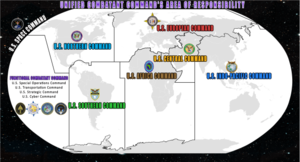
Unified combatant commands are joint military commands consisting of forces from multiple military departments, with their chain of command flowing from the president, to the secretary of defense, to the commanders of the combatant commands. Each service organizes, trains, and equips forces that are then presented to the unified combatant commands through service component commands. Special Operations Command and Cyber Command also present theater special operations commands or joint force headquarters – cyber to other combatant commanders. Army components are typically dual-hatted as the joint force land component, Navy components are typically dual-hatted as the joint force maritime component, and Air Force components are typically dual-hatted as the joint force air component, with the theater special operations command dual-hatted as the joint force special operations component, and Space Force component typically dual-hatted as the joint force space component.[48]
| Name | Mission | Headquarters | Subunified commands | |
|---|---|---|---|---|
 | U.S. Africa Command (USAFRICOM) | Conducts U.S. military operations in Africa. | Kelley Barracks, Germany | |
 | U.S. Central Command (USCENTCOM) | Conducts U.S. military operations in the Middle East and Central Asia. | MacDill Air Force Base, Florida | |
 | U.S. Cyber Command (USCYBERCOM) | Conduct U.S. military cyber operations. | Fort Meade, Maryland | |
 | U.S. European Command (USEUCOM) | Conducts U.S. military operations in Europe. | Patch Barracks, Germany | |
 | U.S. Indo-Pacific Command (USINDOPACOM) | Conducts U.S. military operations in the Indo-Pacific. | Camp H. M. Smith, Hawaii | |
 | U.S. Northern Command (USNORTHCOM) | Conducts U.S. military operations in North America and homeland defense operations. | Peterson Space Force Base, Colorado | |
 | U.S. Southern Command (USSOUTHCOM) | Conducts U.S. military operations in Central America, South America, and the Caribbean. | Doral, Florida | |
 | U.S. Space Command (USSPACECOM) | Conducts U.S. military operations in outer space. | Peterson Space Force Base, Colorado | |
 | U.S. Special Operations Command (USSOCOM) | Develops and employs special operations forces. | MacDill Air Force Base, Florida | |
 | U.S. Strategic Command (USSTRATCOM) | Conduct strategic deterrence, nuclear operations, nuclear command, control, and communications, joint electromagnetic spectrum operations, and global strike.[49] | Offutt Air Force Base, Nebraska | |
 | U.S. Transportation Command (USTRANSCOM) | Conduct globally integrated mobility operations. | Scott Air Force Base, Illinois | |
Combat support agencies
Combat support agencies are Department of Defense agencies with combat support missions that service operating forces planning or conducting military operations. This includes support during conflict or in the conduct of other military activities related to countering threats to U.S. national security. This mission is focused on providing support to echelons at the CCMD level and below and may not encompass the full scope of the CSA's mission.[50]
| Name | Mission | Headquarters | |
|---|---|---|---|
 | Defense Contract Management Agency (DCMA) | Provide contract administration services for the Department of Defense.[51] | Fort Gregg-Adams, Virginia |
 | Defense Health Agency (DHA) | Provide and augment medical capabilities for combatant commands.[52] | Falls Church, Virginia |
 | Defense Information Systems Agency (DISA) | Provide, operate and assure command, control, information-sharing capabilities.[53] | Fort Meade, Maryland |
 | Defense Intelligence Agency (DIA) | Provide military intelligence to warfighters, defense policymakers and force planners in the Department of Defense and Intelligence Community, in support of U.S. military planning and operations and weapon systems acquisition.[54] | Defense Intelligence Agency Headquarters, Joint Base Anacostia–Bolling, Washington D.C. |
 | Defense Logistics Agency (DLA) | Manages the end-to-end global defense supply chain.[55] | Fort Belvoir, Virginia |
 | Defense Threat Reduction Agency (DTRA) | Identify, develop, and field solutions to counter weapons of mass destruction and emerging threats.[56] | Fort Belvoir, Virginia |
 | National Geospatial-Intelligence Agency (NGA) | Delivers geospatial intelligence to policymakers, military service members, intelligence professionals and first responders.[57] | Fort Belvoir, Virginia |
  | National Security Agency / Central Security Service (NSA/CSS) | Provides timely and accurate cryptologic support, knowledge, and assistance to the military cryptologic community.[58] Provide actionable signals intelligence and cybersecurity support to the Armed Forces.[59] | Fort Meade, Maryland |
Service branches
The United States Armed Forces is composed of six coequal military service branches. Five of the branches, the United States Army, United States Marine Corps, United States Navy, United States Air Force, and United States Space Force, are organized under the Department of Defense's military departments. The United States Coast Guard is nominally under the Department of Homeland Security, but may be transferred to the Department of Defense's Department of the Navy (which is the civilian entity that oversees the coequal U.S. Marine Corps and U.S. Navy) at the direction of the President or Congress. With the exception of the Coast Guard, the military services only organize, train, and equip forces. The unified combatant commands are responsible for operational control of non-service retained forces.
Each of the different military services is assigned a role and domain. The U.S. Army conducts land operations, while the U.S. Navy and U.S. Marine Corps conduct maritime operations, with the Marine Corps specializing in amphibious and maritime littoral operations in support of the Navy. The U.S. Air Force conducts air operations, while the U.S. Space Force conducts space operations. The U.S. Coast Guard is unique in that it is a military branch specializing in maritime operations and also a law enforcement agency.[17][18]
U.S. Army
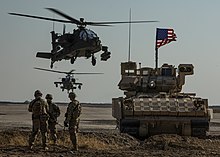
The United States Army (USA) is the United States Armed Forces' land force and is the largest and oldest service. Originally established in 1775 as the Continental Army, it consists of one million soldiers across the Regular Army, Army Reserve, and Army National Guard.[17] The Army serves as the Armed Forces principal land service, responsible for conducting land warfare operations.[60]
The U.S. Army is organized under the Department of the Army, which is a military department under the leadership of the secretary of the Army and under secretary of the Army. The U.S. Army itself is led by the chief of staff of the Army and vice chief of staff of the Army, both generals who are advised by the sergeant major of the Army.[61]
The Army's primary responsibility is to conduct prompt and sustained land combat as part of the joint force. Army landpower focuses on destroying an enemy's armed forces, occupying its territory, and breaking the will of an adversary.[62]
The five core competencies of the Army are:
- Prompt and sustained land combat
- Combined arms operations:
- Combined arms maneuver and wide area security
- Armored and mechanized operations
- Airborne and air assault operations
- Special operations
- Set and sustain the theater for the joint force
- Integrate national, multinational, and joint power on land[62]
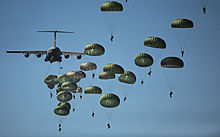
The thirteen specified functions of the Army are:
- Conduct prompt and sustained combined arms combat operations on land in all environments and types of terrain, to include complex urban environments, in order to defeat enemy ground forces, and seize, occupy, and defend land areas.[63]
- Conduct air and missile defense to support joint campaigns and assist in achieving air superiority. This is conducted by the Army's Air Defense Artillery Branch, specifically by the 10th Army Air and Missile Defense Command, 32nd Army Air and Missile Defense Command, 94th Army Air and Missile Defense Command, 263rd Army Air and Missile Defense Command, and Army Space and Missile Defense Command.[63]
- Conduct airborne and air assault, and amphibious operations. The Army has primary responsibility for the development of airborne doctrine, tactics, techniques, and procedures. Army airborne and air assault operations are conducted by the XVIII Airborne Corps, 11th Airborne Division, 82nd Airborne Division, 101st Airborne Division, and the 173rd Airborne Brigade.[63]
- Conduct civil affairs operations. Civil affairs operations are conducted by the United States Army Special Operations Command, predominantly under United States Army Civil Affairs and Psychological Operations Command and the 95th Civil Affairs Brigade.[63]
- Conduct riverine operations.[63]
- Occupy territories abroad and provide for the initial establishment of a military government pending transfer of this responsibility to other authorities.[63]
- Interdict enemy sea power, space power, air power, and communications through operations on and from the land.[63]
- Provide logistics to joint operations and campaigns, including joint over-the-shore and intra-theater transport of time-sensitive, mission-critical personnel and materiel. This is primarily conducted through the Army Logistics Branch, including the Quartermaster Corps, Ordnance Corps, Transportation Corps, and through Army Materiel Command's Military Surface Deployment and Distribution Command.[63]
- Provide support to space operations to enhance joint campaigns, in coordination with the other military services (primarily the United States Space Force), combatant commands (primarily United States Space Command), and other U.S. government departments and agencies. Army space operations are conducted by Army Space and Missile Defense Command.[63]
- Conduct authorized civil works programs, to include projects for the improvement of navigation, flood control, beach erosion control, and other water resource developments in the United States, its territories, and its possessions, and conduct other civil activities prescribed by law. These are conducted by the Army Corps of Engineers.[63]
- Provide intra-theater aeromedical evacuation. These missions are flown by the Army Medical Service Corps and Army Aviation Branch.[63]
- Conduct reconnaissance, surveillance, and target acquisition.
- Operate land lines of communication. This is primarily conducted through the Transportation Corps and Military Surface Deployment and Distribution Command.[63]
Infantry
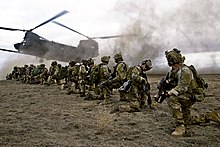
The Infantry Branch forms the core of the service's land combat power. U.S. Army infantry are generally equipped with the M4 carbine and M249 light machine gun, which will be replaced by the XM7 rifle and XM250.[64]
Infantry is a core part of the Army's Brigade Combat Teams. The most numerous variant, the Infantry Brigade Combat Team, comprises light infantry battalions who fight on foot. Infantry Brigade Combat Teams of the 82nd Airborne Division are air assault capable, with infantry soldiers being transported by U.S. Army Aviation UH-60 Black Hawk and CH-47 Chinook helicopters.[65] Infantry Brigade Combat Teams of the 11th Airborne Division, 82nd Airborne Division, and 173rd Airborne Brigade are capable of airborne operations, in cooperation with the U.S. Air Force's transport aircraft.[66] Finally, Infantry Brigade Combat Teams assigned to the 10th Mountain Division specialize in mountain warfare.[67] Standard Infantry Brigade Combat Teams are assigned to the 25th Infantry Division, which offers additional training in jungle warfare.[68]
Armored Brigade Combat Teams comprise mechanized infantry battalions mounted in the M2 Bradley infantry fighting vehicle. Divisions with Armored Brigade Combat Teams include the 1st Infantry Division, 3rd Infantry Division, 4th Infantry Division, 1st Armored Division, and 1st Cavalry Division.[69] Stryker Brigade Combat Teams are centered around Stryker infantry battalions operating out of the Stryker. Divisions with Stryker Brigade Combat Teams include the 2nd Infantry Division, 4th Infantry Division, 11th Airborne Division, 2nd Cavalry Regiment, and 3rd Cavalry Regiment.[69]
United States Army Rangers with the 75th Ranger Regiment are an elite special operations infantry force in the United States Army Special Operations Command, specializing in air assault and airborne infiltration methods. The three primary missions of the 75th Ranger Regiment are special operations raids, forcible entry operations, such as an airfield seizure to enable the Air Force to bring in more forces, and special reconnaissance.[70][71] As a special operations force, Army Rangers are generally better equipped than standard infantry, utilizing the FN SCAR rifle.[72]
Army Special Forces

Army Special Forces, commonly known as Green Berets after their iconic headgear, are among the most elite soldiers in the Army. Special Forces conduct:[73]
- counterinsurgency distinguishing between civilians and enemy combatants while assisting with the stabilization, defense, and training of developing countries facing insurgent threats.
- direct action seizing, capturing, recovering, or destroying enemy material; or utilizing quick strikes to recover personnel.
- foreign internal defense training and equipping foreign allied military forces to defend against insurgency, subversion, terrorism, and other security threats.
- special reconnaissance executing surveillance in hostile, denied, or diplomatically- or politically-sensitive environments to collect or verify information of strategic significance.
- unconventional warfare enabling a resistance movement or insurgency to coerce, disrupt, or overthrow a government or occupying power by operating through or with an underground force in a denied area.
Army Special Forces are trained in military free-fall parachuting and combat diver skillsets.[73] They are considered the most versatile special operations force in the entire world, operating as a multi-purpose force since 1952.[74]
Armor and Cavalry

The Armor Branch traces its history back to the United States Cavalry and are responsible for tank and cavalry reconnaissance operations.[75]
The U.S. Army fields the M1 Abrams main battle tank in Armored Battalions as part of Armored Brigade Combat Teams across the 1st Armored Division, 1st Cavalry Division, 1st Infantry Division, 3rd Infantry Division, and the 4th Infantry Division. Each Armored Brigade Combat Team also possesses a cavalry squadron equipped with M2 Bradleys for scouting and security. Stryker Brigade Combat Teams from the 2nd Infantry Division, 4th Infantry Division, 11th Airborne Division, 2nd Cavalry Regiment, and 3rd Cavalry Regiment have a cavalry squadron equipped with Strykers. Infantry Brigade Combat Teams from the 10th Mountain Division, 11th Airborne Division, 25th Infantry Division, 82nd Airborne Division, 101st Airborne Division, and 173rd Airborne Brigade have a cavalry squadron equipped with the Joint Light Tactical Vehicle.[76]
Field Artillery
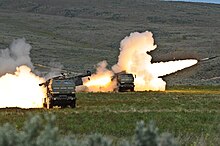
The Field Artillery's mission is to destroy, suppress or neutralize the enemy by cannon, rocket or missile fire.[77] Rocket systems include the M142 HIMARS and M270 Multiple Launch Rocket System, which are corps-level assets found in field artillery brigades. Towed artillery includes the M119 howitzer in Infantry Brigade Combat Teams and the M777 howitzer found in both Infantry and Stryker Brigade Combat Teams. The M109 self-propelled howitzer is utilized in Armored Brigade Combat Teams.[78]
During the Cold War, Army field artillery was responsible for the service's ballistic missile programs, including the PGM-11 Redstone, which was the first large ballistic missile in the U.S. arsenal, the MGM-31 Pershing, and the Pershing II.[79] In 2023, the Army is intending to field the Long-Range Hypersonic Weapon and has reestablished larger artillery formations like the 56th Artillery Command.[80][81][82]
Air Defense Artillery
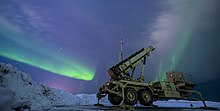
The Air Defense Artillery is responsible for defending geopolitical assets and providing maneuver forces with the freedom to move on the battlefield by deterring the enemy and destroying aerial threats, missile attacks, and surveillance platforms.[83] Weapons employed by Air Defense Artillery include the FIM-92 Stinger man-portable air-defense system, AN/TWQ-1 Avenger for short range air defense, and the counter rocket, artillery, and mortar 20mm gun system. The Iron Dome provides air defense against rockets, artillery, mortars, missiles, and unmanned aerial vehicles. The MIM-104 Patriot is capable of defeating a wide range of threats including aircraft, helicopters, UAVs, ballistic and cruise missiles, and Weapons of Mass Destruction.[83]
The Terminal High Altitude Area Defense protects strategic critical assets by conducting long-range endo-and-exo-atmospheric engagements of ballistic missiles using the world's largest air-transportable X-band radar. The Ground-Based Midcourse Defense is an anti-ballistic missile system operated by Army Space and Missile Defense Command to defend the United States homeland against an intercontinental ballistic missile attack.[83] Major Air Defense Artillery units include the 32nd Army Air and Missile Defense Command and Army Space and Missile Defense Command's 100th Missile Defense Brigade.[84][85]
Air Defense Artillery has an extremely close relationship with the Air Force through its Air and Missile Defense Commands and the Space Force through Army Space and Missile Defense Command, given their shared missile defense and space roles. In 1962, Air Defense Artillery achieved the first intercept of a ballistic missile with a nuclear-tipped Nike Zeus and operated the Nike Zeus as an anti-satellite weapon after completing a successful intercept in 1963.[86][87]
Army Aviation
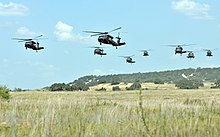
Army Aviation, distinct from the U.S. Air Force and its predecessors, began as part of the field artillery in 1942. Small spotter planes were used to spot for artillery and naval bombardment, as well as to perform observation. These few aircraft formed the core of Army Aviation once the U.S. Air Force gained independence. In 1983, the Army created the Aviation Branch, for the first time since the Air Force's independence consolidating aviation under a single organization.[88]
The mission of Army Aviation is to find, fix and destroy any enemy through fire and maneuver and to provide combat support and combat service support in coordinated operations as an integral member of the combined arms team.[89] Major aircraft include the AH-64 Apache, which serves as the Army's attack helicopter, the UH-60 Black Hawk, and the CH-47 Chinook for troop and cargo transport. Army Aviation also flies the MQ-1C Gray Eagle drone.[90]
A specialized unit within Army Aviation, the 160th Special Operations Aviation Regiment (Airborne) serves as a special operations unit and operates modified variants of the MH-60 Black Hawk, MH-47 Chinook, and the MH-6 Little Bird.[91]
Army commands
The U.S. Army is organized into four major Army Commands, nine Army Service Component Commands which serve as the Army component and joint force land component commanders for the unified combatant commands, and thirteen direct reporting units.[92]
| Name | Mission | Headquarters | ||
|---|---|---|---|---|
 | Headquarters Department of the Army (HQDA) | Army service headquarters led by the chief of staff of the Army. | The Pentagon, Virginia | |
| Army Commands and reserve components | ||||
 | U.S. Army Forces Command (FORSCOM) | Provides Army land forces to unified combatant commands.[93] | Fort Liberty, North Carolina | |
 | U.S. Army Materiel Command (AMC) | Provides technology, acquisition support, and logistics for Army land forces.[94] | Redstone Arsenal, Alabama | |
 | U.S. Army Training and Doctrine Command (TRADOC) | Recruits, trains, and educates Army soldiers and develops Army doctrine.[95] | Fort Eustis, Virginia | |
 | U.S. Army Futures Command (AFC) | Leads Army modernization efforts, including developing future force requirements, designing future force organizations, and delivering materiel capabilities.[96] | Austin, Texas | |
 | U.S. Army Reserve (USAR) | Oversees and maintains Army reserve forces | Fort Liberty, North Carolina | |
 | Army National Guard (ARNG) | Army component of the National Guard. | The Pentagon, Virginia | |
U.S. Marine Corps
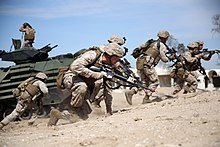
The United States Marine Corps (USMC) serves as the U.S. Armed Forces' naval land force, responsible for executing amphibious warfare and operating in the maritime littorals in support of the U.S. Navy. Originally established in 1775 as the Continental Marines, the Marine Corps consists of the Regular Marine Corps and the Marine Corps Reserve.[97] The Marine Corps maintains a very close relationship with the U.S. Navy, its sister service in the Department of the Navy. Although the Marine Corps has previously operated as an independent land force alongside the Army, its primary purpose is to serve as part of a unified naval service alongside the Navy in the maritime domain.[98]
The U.S. Marine Corps is organized under the Department of the Navy, which is a military department under the leadership of the secretary of the Navy and the under secretary of the Navy. The U.S. Marine Corps itself is led by the commandant of the Marine Corps and the assistant commandant of the Marine Corps, both generals who are advised by the sergeant major of the Marine Corps.[97]
The Marine Corps statutory mission is outlined in 10 U.S.C. § 5063 and as originally introduced under the National Security Act of 1947, with its three primary areas of responsibility including:
- Seizure or defense of advanced naval bases and other land operations to support naval campaigns;
- Development of tactics, technique, and equipment used by amphibious landing forces in coordination with the Army and Air Force; and
- Such other duties as the President or Department of Defense may direct.
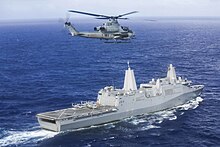
The seven specified functions of the Marine Corps are:
- Seize and defend advanced naval bases or lodgments to facilitate subsequent joint operations.[63]
- Provide close air support for ground forces.[63]
- Conduct land and air operations essential to the prosecution of a naval campaign or as directed.[63]
- Conduct complex expeditionary operations in the urban littorals and other challenging environments.[63]
- Conduct amphibious operations, including engagement, crisis response, and power projection operations to assure access. The Marine Corps has primary responsibility for the development of amphibious doctrine, tactics, techniques, and equipment.[63]
- Conduct security and stability operations and assist with the initial establishment of a military government pending transfer of responsibility to other authorities.[63]
- Provide security detachments and units for service on armed vessels of the Navy, provide protection of naval property at naval stations and bases, provide security at designated U.S. embassies and consulates, and perform other such duties as the president or secretary of defense may direct. These additional duties may not detract from or interfere with the operations for which the Marine Corps is primarily organized.
Marine Corps Security Force Regiment is responsible for supporting the Navy with Marine security operations, while the Marine Security Guard protects embassies and consulates of the United States Department of State.[63]
Fleet Marine Force

The combat power of the Marine Corps is centralized in the Fleet Marine Force (FMF), which itself is organized into Fleet Marine Force Atlantic, to support the U.S. Navy's Fleet Forces Command, and Fleet Marine Force Pacific, which supports the U.S. Navy's U.S. Pacific Fleet.[98]
The basic Marine Corps unit for conducting operations is the Marine Air-Ground Task Force (MAGTF), which combines Marine Corps and Navy land, air, sea, and cyberspace capabilities into a single command. There are three size variants of a Marine Air-Ground Task Force, but each consists of a command element, ground combat element, aviation combat element, and logistics combat element.[99]
A Marine ground combat element (GCE) is centered around Marine infantry, typically armed with a M27 Infantry Automatic Rifle.[100] Unlike the Army, the Marine Corps does not train its own combat medics, relying on the Navy to provide hospital corpsmen.[101] These infantry units are supported by Marine Corps combat engineers, who conduct engineer reconnaissance, obstacle system emplacement, and breaching operations; and Marine Corps Force Reconnaissance teams. While the Marine Corps no longer operates its own tanks, opting to request support from the Army if needed, it maintains Light Armored Reconnaissance Battalions which operate the LAV-25 amphibious armored reconnaissance vehicle. Assault Amphibian Battalions operate the Assault Amphibious Vehicle and Amphibious Combat Vehicle, which enable the ground combat element to conduct amphibious landing operations.[102] Marine Corps artillery operates the M777 howitzer and the M142 HIMARS, both supporting the ground combat element and the Navy at sea by striking enemy ships.[103][104]
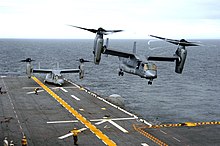
The Marine aviation combat element (ACE) is the operational arm of Marine Corps Aviation, working to support the ground combat element. The F-35B Lightning II and AV-8B Harrier II are flown off Navy amphibious assault ships, while the F-35C Lightning II and F/A-18 Hornet are flown off Navy carriers by Marine Corps pilots. The Marine Corps also operates the KC-130J to serve as a tanker and tactical airlift platform. The UH-1Y Venom helicopter provides the Marine Corps with light transport and attack, while the AH-1Z Viper is a dedicated attack helicopter. Medium-lift squadrons fly the MV-22 Osprey, while heavy-lift squadrons use the CH-53K King Stallion. The Marine Corps has also begun flying unmanned aerial vehicles, such as the MQ-9 Reaper and MQ-8 Fire Scout.[105] Notably, the aviation combat element also includes Low-Altitude Air Defense Battalions, which employ the FIM-92 Stinger surface-to-air missile.[106]
The smallest MAGTF is the Marine Expeditionary Unit (MEU), which is typically forward deployed on a Navy ship. Commanded by a colonel, a Marine Expeditionary Unit consist of 2,200 marines split across a battalion landing team (ground combat element), a composite helicopter squadron (aviation combat element), and a combat logistics element (logistics element). Marine Expeditionary Units are supplied for 15 days.[99] Forward deployed Marine Expeditionary Units are often embarked on Navy amphibious assault ships as part of an amphibious ready group.[107]
The mid-sized MAGTF is the Marine Expeditionary Brigade (MEB), which is organized for specific missions. Commanded by a brigadier general, Marine Expeditionary Brigades consist of 4,000 to 16,000 marines across a Regimental-sized ground combat element, a Marine Aircraft Group, and a Combat Logistics Regiment. Marine Expeditionary Brigades are supplied for 30 days and offer increased firepower and airpower over the Marine Expeditionary Unit.[99]
The largest MAGTF is the Marine Expeditionary Force (MEF), which is the primary warfighting force for larger operations. A Marine Expeditionary Force is commanded by a lieutenant general and consists of 46,000 to 90,000 marines. Currently there are only three Marine Expeditionary Forces, each with its own Marine Division, Marine Aircraft Wing, Marine Logistics Group, and Marine Expeditionary Force Information Group. Marine Expeditionary Forces are supplied for 60 days.[99] Certain elements are held at the Marine Expeditionary Force level, such as Force Reconnaissance. The MEF Information Group (MIG) also provides a number of functions such as the intelligence battalion; radio battalion which conducts signals intelligence, electronic warfare, and cyberspace operations; communications battalion; the MEF support battalion; and the Air Naval Gunfire Liaison Company.[108][109]
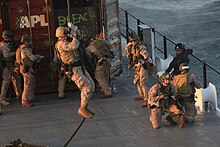
While not a MAGTF, the Marine Corps has begun to reorganize some of its regiments into Marine Littoral Regiments (MRL), which are similar in size to a Marine Expeditionary Unit. A Marine Littoral Regiment is a self-deployable force, designed to be naval in nature and operate in the littoral region. A Marine Littoral Regiment consists of a littoral combat team, a littoral anti-air battalion, and a combat logistics battalion. Notably, the Marine Littoral Regiment has no aviation combat element, unlike a Marine Expeditionary Unit.[110]
Another Marine Corps element that does not function as part of the MAGTF is the Marine Raider Regiment, functioning under United States Marine Forces Special Operations Command. Marine Raiders specialize in direct action, unconventional warfare, maritime interdiction, special reconnaissance, foreign internal defense, counterterrorism, and counterinsurgency missions.[111]
Marine Corps commands
Under Headquarters Marine Corps, the Marine Corps is organized into the Fleet Marine Force, multiple commands, and Marine Corps service components to the unified combatant commands.
| Name | Mission | Headquarters | ||
|---|---|---|---|---|
 | Headquarters Marine Corps (HQMC) | Marine Corps service headquarters led by the commandant of the Marine Corps. | The Pentagon, Virginia | |
| Fleet Marine Force | ||||
 | Fleet Marine Force, Atlantic (FMFLANT) / U.S. Marine Corps Forces Command (MARFORCOM) | Provides Marine Corps forces in support of the U.S. Navy's United States Fleet Forces Command. Also serves as United States Marine Corps Forces Command, commanding Marine Corps retained service forces and providing forces for joint, naval, and service requirements.[112] | Naval Support Activity Hampton Roads, Virginia | |
 | Fleet Marine Force, Pacific (FMFPAC) | Provides Marine Corps forces in support of the U.S. Navy's United States Pacific Fleet.[113] | Camp H. M. Smith, Hawaii | |
 | Marine Corps Systems Command (MARCORSYSCOM) | Acquisition command for all Marine Corps ground and information technology programs.[114] | Marine Corps Base Quantico, Virginia | |
 | U.S. Marine Corps Forces Reserve (MARFORRES) | Oversees and maintains the U.S. Marine Corps reserve forces.[115] | Marine Corps Support Facility New Orleans, Louisiana | |
U.S. Navy

The United States Navy (USN) is the United States Armed Forces' maritime force. Originally established in 1775 as the Continental Navy, the U.S. Navy consists of the Regular Navy and the Navy Reserve. The Navy is the United States' principal maritime service, responsible for maritime warfare operations.[116]
The U.S. Navy is organized under the Department of the Navy, which is a military department under the leadership of the secretary of the Navy and the under secretary of the Navy. The U.S. Navy itself is led by the chief of naval operations and the vice chief of naval operations, both admirals who are advised by the master chief petty officer of the Navy.[116]
The five enduring functions of the Navy are:[117]

The nine specified tasks of the Navy are:
- Conduct offensive and defensive operations associated with the maritime domain including achieving and maintaining sea control, to include subsurface, surface, land, air, space, and cyberspace.[63]
- Provide power projection through sea-based global strike, to include nuclear and conventional capabilities; interdiction and interception capabilities; maritime and littoral fires, to include naval surface fires; and close air support for ground forces.[63]
- Conduct ballistic missile defense. This is executed through the Navy's Aegis Ballistic Missile Defense System.[63]
- Conduct ocean, hydro, and river survey and reconstruction.[63]
- Conduct riverine operations. This is conducted by the Maritime Expeditionary Security Force and Naval Special Warfare Command.[63]
- Establish, maintain, and defend sea bases in support of naval, amphibious, land, air, or other joint operations as directed.[63]
- Provide naval expeditionary logistics to enhance the deployment, sustainment, and redeployment of naval forces and other forces operating within the maritime domain, to include joint sea bases, and provide sea transport for the Armed Forces other than which is organic to the individual military services, United States Special Operations Command, and United States Cyber Command. This is conducted by the Navy Expeditionary Logistics Support Group and Military Sealift Command.[63]
- Provide support for joint space operations to enhance naval operations, in coordination with the other military services (primarily the United States Space Force), combatant commands (primarily United States Space Command), and other U.S. government departments and agencies. U.S. Navy space operations are conducted by Navy Space Command.[63]
- Conduct nuclear operations in support of strategic deterrence, to include providing and maintaining nuclear surety and capabilities.[63]
Naval Surface Forces
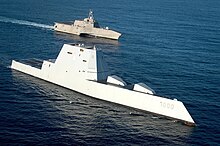
The Naval Surface Forces (NAVSURFOR) is the backbone of the U.S. Navy's combat power, conducting surface warfare operations and operating its fleet of combat surface ships.[118]
The Naval Surface Forces operates eleven nuclear-powered aircraft carriers (CVN), split between the Nimitz-class and the newer Gerald R. Ford-class. Aircraft carriers are the centerpiece of the U.S. Navy's combat power, forming the nucleus of its eleven carrier strike groups (CSG). Each aircraft carrier has an embarked carrier air wing from the Naval Air Forces.[119]
The Naval Surface Forces also operate 116 surface combatants. These include the Ticonderoga-class guided-missile cruisers, Arleigh Burke-class guided-missile destroyers (DDG) and Zumwalt-class stealth guided-missile destroyers. Cruisers and destroyers often operate as part of larger formations, where they serve as escorts for anti-aircraft and anti-submarine operations. However, they also are able to conduct sea control and striker operations ashore with their tomahawk cruise missiles. The Navy also operates a complement of smaller Freedom-class and Independence-class littoral combat ships (LCS) that can be modularly reconfigured for specific mission sets.[120][121] Having lacked a frigate since the Oliver Hazard Perry-class was decommissioned, the Navy is in the process of acquiring the new Constellation-class guided-missile frigates (FFG).[122]
Finally, the Naval Surface Forces operate 31 amphibious warfare ships to support the Fleet Marine Force and its embarked Marine Air-Ground Task Forces as part of an amphibious ready group or expeditionary strike group. This includes the America-class landing helicopter assault (LHA) ships which can carry U.S. Marine Corps F-35B Lightning II fighters and helicopters; and Wasp-class landing helicopter dock (LHD) ships, which can carry both F-35B fighters, helicopters, and landing craft. These are in addition to the San Antonio-class amphibious transport docks (LPD), and the Whidbey Island-class and Harpers Ferry-class dock landing ships.[123][124]
Naval Submarine Forces
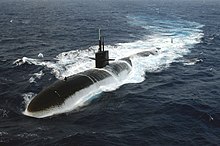
The Naval Submarine Forces (NAVSUBFOR) is often referred to as the "silent service", consisting of 68 commissioned submarines.[125]
Los Angeles-class, Seawolf-class, and Virginia-class nuclear-powered attack submarines are capable of performing sea control missions by destroying enemy submarines and surface ships, conducting surveillance and reconnaissance, performing irregular warfare, covert troop insertion, mine and anti-mine operations, and land attack missions with tomahawk cruise missiles.[126]
Ohio-class nuclear-powered ballistic missile submarines (SSBN) have the sole mission of being launch platforms for the nuclear submarine-launched ballistic missile (SLBM). Each carries 20 UGM-133 Trident II SLBMs. The Navy is currently in the process of procuring the Columbia-class SSBNs to replace the Ohio-class.[127] Some Ohio-class submarines have been converted to cruise-missile submarines (SSGN), capable of carrying 154 tomahawk cruise missiles and deploying 66 special operations forces personnel, such as Navy SEALs.[128]
Naval Air Forces
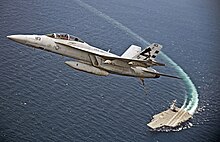
The Naval Air Forces (NAVAIRFOR) is the Navy's naval aviation arm, centered around the carrier air wing. The core of the carrier air wing are the Naval Air Forces strike fighter squadrons (VFA), which fly the F-35C Lightning II stealth fighter and the F/A-18E/F Super Hornet. A variant of the F/A-18, the EA-18G Growler is an electronic-warfare aircraft flown by electronic attack squadrons (VAQ) off of carriers or land bases. The E-2 Hawkeye provides carriers with airborne early warning and command-and-control, while the C-2A Greyhound keeps carriers supplied. The CMV-22B Osprey is currently in the process of replacing the C-2 Greyhound for carrier resupply.[129]
The Naval Air Forces also operate the MH-60 Seahawk for anti-submarine warfare, anti-ship warfare, and search and rescue operations. The MH-53E is primarily used for anti-mine warfare but can also be used for assault support.[129]
Although primarily centered on carriers, the Naval Air Forces do operate a small number of land-based aircraft. These include the P-3C Orion and P-8A Poseidon, which conduct anti-submarine warfare operations and serve as maritime patrol aircraft, alongside the unmanned MQ-4C Triton. The E-6 Mercury is also flown by the Navy to communicate instructions to U.S. strategic forces.[130][129]
Navy commands
The U.S. Navy is organized into eight navy component commands, which command operational forces and serve as joint force maritime component commands; fifteen shore commands, which support the fleets' operating forces; five systems commands, which oversee the technical requirements of the Navy; and nine type commands, which administratively manage units of a certain type.
| Name | Mission | Headquarters | ||
|---|---|---|---|---|
 | Office of the Chief of Naval Operations (OPNAV) | Navy service headquarters led by the chief of naval operations. | The Pentagon, Virginia | |
| Navy operating forces | ||||
 | U.S. Fleet Forces Command (USFF) / U.S. Naval Forces Northern Command (NAVFORNORTH) | Trains, certifies, and provides Navy forces for naval, joint, and combined operations. Navy service component and joint force maritime component command to United States Northern Command and United States Strategic Command.[131] | Naval Support Activity Hampton Roads, Virginia | |
 | U.S. Pacific Fleet (PACFLT) | Navy service component and joint force maritime component command to United States Indo-Pacific Command. | Naval Station Pearl Harbor, Hawaii | |
 | U.S. Naval Forces Central Command (NAVCENT) | Navy service component and joint force maritime component command to United States Central Command. | Naval Support Activity Bahrain | |
  | U.S. Fleet Cyber Command (FCC) / U.S. Navy Space Command (NAVSPACE) | Navy service component to United States Cyber Command and United States Space Command | Fort Meade, Maryland | |
 | U.S. Naval Forces Europe and Africa (NAVEUR-NAVAF) | Navy service component and joint force maritime component command to United States European Command and United States Africa Command. | Naval Support Activity Naples, Italy | |
 | U.S. Naval Forces Southern Command (NAVSO) | Navy service component and joint force maritime component command to United States Southern Command. | Naval Station Mayport, Florida | |
 | U.S. Naval Special Warfare Command (USNSWC) | Navy service component to United States Special Operations Command. | Naval Amphibious Base Coronado, California | |
 | Military Sealift Command (MSC) | Navy service component and joint force maritime component command to United States Transportation Command. | Naval Station Norfolk, Virginia | |
 | U.S. Navy Reserve (USNR) | Oversees and maintains Navy reserve forces | Naval Support Activity Hampton Roads, Virginia | |
U.S. Air Force

The United States Air Force (USAF) is the United States Armed Forces' air force. Originally established in 1947 when it gained independence from the U.S. Army, it traces its history back through the United States Army Air Forces, United States Army Air Corps, United States Army Air Service, the Division of Military Aeronautics, Aviation Section, U.S. Signal Corps, to the birth of Aeronautical Division, U.S. Signal Corps on 1 August 1907. The U.S. Air Force serves as the principal air service, responsible for aerial warfare operations. The U.S. Air Force is composed of the Regular Air Force, Air Force Reserve, and Air National Guard.[132]
The U.S. Air Force is organized under the Department of the Air Force, which is a military department under the leadership of the secretary of the Air Force and under secretary of the Air Force. The U.S. Air Force itself is led by the chief of staff of the Air Force and vice chief of staff of the Air Force, both generals who are advised by the chief master sergeant of the Air Force.
The five core missions of the Air Force are:[133]
- Air superiority
- Global integrated intelligence, surveillance, and reconnaissance
- Rapid global mobility
- Global strike
- Command and control
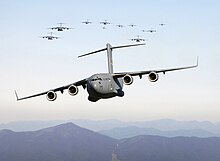
The eight specified functions of the Air Force are:[134]
- Conduct nuclear operations in support of strategic deterrence, to include providing and maintaining nuclear surety and capabilities.
- Conduct offensive and defensive operations, to include appropriate air and missile defense, to gain and maintain air superiority and air supremacy as required, to enable the conduct of operations by U.S. and allied land, sea, air, space, and special operations forces.
- Conduct global precision attack, to include strategic attack, interdiction, close air support, and prompt global strike.
- Provide timely, globally integrated intelligence, surveillance, and reconnaissance capability and capacity from forward deployed locations and globally distributed centers to support world-wide operations.
- Provide rapid global mobility to employ and sustain organic air and space forces and other military service and U. S. Special Operations Command forces, as directed, to include airlift forces for airborne operations, air logistical support, tanker forces for in-flight refueling, and assets for aeromedical evacuation.
- Provide agile combat support to enhance the air and space campaign and the deployment, employment, sustainment, and redeployment of air and space forces and other forces operating within the air and space domains, to include joint air and space bases, and for the Armed Forces other than which is organic to the individual military services and U.S. Special Operations Command in coordination with the other military services, combatant commands, and U.S. Government departments and agencies.
- Conduct global personnel recovery operations including theater-wide combat and civil search and rescue in coordination with the other military services, combatant commands, and DoD components.
- Conduct globally integrated command and control for air and space operations.
Combat Air Force
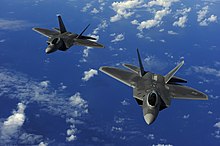
The Combat Air Force (CAF) comprises the majority of the Air Force's combat power, consisting of its fighter, bomber, intercontinental ballistic missile, and special operations forces.[135]
The Air Force's fighter forces are led by Air Combat Command's Fifteenth Air Force, with other fighter units under Pacific Air Forces and United States Air Forces in Europe. Air Force fighters are predominantly used to achieve air superiority and strike enemy ground and naval forces. The Air Force operates an expanding force of fifth-generation fighters. The F-22A Raptor stealth fighter is designed to replace the F-15C in air superiority operations carrying two AIM-9 Sidewinder and six AIM-120 AMRAAM missiles. It also has a significant air-to-ground mission, carrying two GBU-32 Joint Direct Attack Munition bombs, in addition to two AIM-9 and two AIM-120 missiles.[136] Ultimately, the F-22 is intended to be replaced by the sixth-generation fighter, Next Generation Air Dominance program.[137] The F-22 is complemented by the more numerous F-35A Lightning II multi-role stealth fighters, which are in the process of replacing the F-16C fighters and A-10 attack aircraft in air superiority and ground attack roles, to include the nuclear strike mission.[138][139]
The Air Force still operates an extremely sizable force of fourth-generation fighters. The F-15C Eagle is a dedicated air superiority fighter, while the F-15E Strike Eagle has been modified to be a dual-role strike fighter, carrying both conventional and nuclear weapons.[140][141] The F-15C Eagle and F-15E Strike Eagle are both being replaced by the F-15EX Eagle II, which is significantly more advanced.[142] The F-16C Fighting Falcon is a multirole fighter that has served as the primary Air Force fighter for decades, including as a dual-capable tactical nuclear strike fighter.[143][144] The A-10C Thunderbolt II attack aircraft has been the first Air Force fighter specifically designed for close air support missions, operating against enemy ground forces and light naval ships with its GAU-8 Avenger gatling cannon and array of air-to-ground munitions.[145]
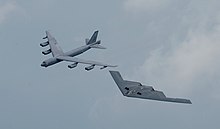
The Air Force's bomber forces are organized under Air Force Global Strike Command's Eighth Air Force, executing long-range strike operations. The B-2A Spirit stealth bomber is capable of conducting both conventional and nuclear strike operations flying through air defenses.[146] The B-1B Lancer, in contrast, is a supersonic bomber that carries only conventional munitions and serves as the backbone of the bomber force.[146] Both the B-2A Spirit and the B-1B Lancer are being replaced by the B-21 Raider stealth bomber, which can be equipped with both conventional and nuclear munitions.[147] The B-52H Stratofortress is a long-range, heavy bomber that the Air Force has flown since the 1950s and operates a variety of conventional and nuclear munitions, including the AGM-86 air-launched cruise missile.[148]
The Air Force's intercontinental ballistic missile forces are organized under Air Force Global Strike Command's Twentieth Air Force, serving as the land component of the nuclear triad. The LGM-30G Minuteman III serves as the only ballistic missile operated by the Air Force, with 400 stationed in hardened silos.[149] The LGM-30G will be replaced by the LGM-35A Sentinel intercontinental ballistic missile.[150]

The Air Force's special operations forces are organized under Air Force Special Operations Command, consisting of both special operations aviation and Air Force special tactics airmen on the ground. The AC-130J Ghostrider gunships have the primary mission of close air support and air interdiction, using cannons and precision guided munitions.[151] The MC-130J Commando II, also a variant of the C-130 Hercules, fly exfiltration and resupply operations for special operations forces, along with conducting air-to-air refueling for helicopters.[152] The CV-22 Osprey is a tiltrotor aircraft used for the infiltration and exfiltration of special operations forces.[153] While not under Air Force Special Operations Command, rescue operations are supported by the HC-130J Combat King II and HH-60W Jolly Green II combat rescue aircraft.[154] The MQ-9 Reaper also serves as a remotely piloted intelligence and strike aircraft, serving under Air Force Special Operations Command and Air Combat Command.[155]
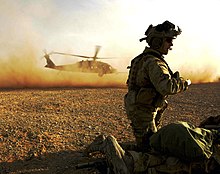
Air Force Special Tactics are the ground special warfare force of the U.S. Air Force, integrating air-ground operations. Special Tactics conduct four core missions. Global access teams assess and open airfields, ranging from international airports to dirt strips, in permissive or hostile locations to facilitate the landing and operation of air forces. Precision strike teams are trained to direct aircraft and other forces to conduct kinetic and non-kinetic strikes, as well as humanitarian aid drops. Special Tactics teams also conduct personnel recovery missions, possessing significant medical and rescue experience. Finally, Special Operations Surgical Teams conduct surgery and medical operations in battlefield operations in support of special operations.[156]
The Air Force also operates a wide array of reconnaissance aircraft under Air Combat Command's Sixteenth Air Force, including the RQ-4 Global Hawk drone, U-2 Dragon Lady, and RC-135 Rivet Joint. Air Force operations are typically supported by command and control aircraft, such as the E-3 Sentry airborne warning and control system. The E-3 Sentry is in the process of being replaced by the E-7A Wedgetail.[157]
Mobility Air Force
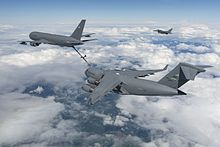
The Mobility Air Force (MAF) is organized under Air Mobility Command and comprises the Air Force's airlift, air refueling, and aeromedical evacuation forces.[158]
The airlift forces operate three different major aircraft. The C-5M Super Galaxy is the largest aircraft in the Air Force, serving as a strategic transport aircraft.[159] The C-17A Globemaster III is the airlift force's most flexible aircraft, conducting both strategic and tactical airlift operations. It is also capable of conducting airborne operations for the Army and aerial resupply through airdropping cargo.[160] Finally, the C-130J Super Hercules is a tactical airlifter, conducting both cargo airlift and supporting Army airborne operations.[161] Other major airlift platforms include the VC-25, which serves as the personal plane of the president of the United States, better known as Air Force One.[162]
The Air Force also operates three major aerial refueling tankers. The KC-46A Pegasus is its most modern tanker, replacing the aging KC-10A Extenders.[163] The remaining tanker is the KC-135 Stratotanker, which has flown since the 1950s.[164] Tankers are also capable of conducting limited airlift operations.
Air Force commands
The U.S. Air Force is organized into nine major commands, which conduct the majority of the service's organize, train, and equip functions. It commands forces attached to the combatant commands as joint force air component commands.[165]
| Name | Mission | Headquarters | |
|---|---|---|---|
 | Headquarters Air Force (HAF) | Air Force service headquarters led by the chief of staff of the Air Force. | The Pentagon, Virginia |
| Major Commands and Air National Guard | |||
 | Air Combat Command (ACC) | Primary provider of combat air forces to the unified combatant commands. Air Combat Command operates fighter, reconnaissance, battle-management, and electronic-combat aircraft.[166] | Joint Base Langley-Eustis, Virginia |
 | Air Education and Training Command (AETC) | Recruits, trains, and educates airmen and develops Air Force doctrine.[167] | Joint Base San Antonio, Texas |
 | Air Force Global Strike Command (AFGSC) | Operates the Air Force strategic bomber and intercontinental ballistic missile forces. Air Force component and joint force air component command for United States Strategic Command.[168] | Barksdale Air Force Base, Louisiana |
 | Air Force Materiel Command (AFMC) | Manages installation and mission support, discovery and development, test and evaluation, and life cycle management services and sustainment for every major Air Force weapon system.[169] | Wright-Patterson Air Force Base, Ohio |
 | Air Force Reserve Command (AFRC) | Manages Air Force reserve forces. | Robins Air Force Base, Georgia |
 | Air Force Special Operations Command (AFSOC) | Organizes, trains, and equips air commandos. Air Force component and joint force air component command for United States Special Operations Command.[170] | Hurlburt Field, Florida |
 | Air Mobility Command (AMC) | Primary provider of air mobility forces to the unified combatant commands. Air Force component and joint force air component command for United States Transportation Command.[171] | Scott Air Force Base, Illinois |
 | Pacific Air Forces (PACAF) | Air Force component and joint force air component command for United States Indo-Pacific Command. | Joint Base Pearl Harbor–Hickam, Hawaii |
  | United States Air Forces in Europe - Air Forces Africa (USAFE-AFAFRICA) | Air Force component and joint force air component command for United States European Command and United States Africa Command. | Ramstein Air Base, Germany |
 | Air National Guard (ANG) | Air Force component of the National Guard. | The Pentagon, Virginia |
U.S. Space Force

The United States Space Force (USSF) is the United States Armed Forces' space force and is the newest military branch. Originally established in 2019, it traces its history through Air Force Space Command and the Western Development Division to 1954. The United States Space Force is the principal space service, responsible for space warfare operations.[172] The U.S. Space Force is composed of the Regular Space Force, not yet having organized a reserve component outside of the Air Force.
The U.S. Space Force is organized under the Department of the Air Force, which is a military department under the leadership of the secretary of the Air Force and under secretary of the Air Force. The U.S. Space Force itself is led by the chief of space operations and vice chief of space operations, both generals who are advised by the chief master sergeant of the Space Force.[173]
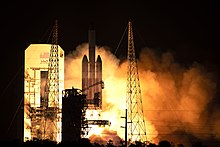
The five core competencies of the Space Force are:[174]
- Space security
- Combat power projection
- Space mobility and logistics
- Information mobility
- Space domain awareness
The five specified functions of the Space Force are:
- Provide freedom of operation for the United States in, from, and to space.[63]
- Provide prompt and sustained space operations.[63]
- Protect the interests of the United States in space.[63]
- Deter aggression in, from, and to space.[63]
- Conduct space operations.[63]
Orbital warfare and space electromagnetic warfare
The Space Force's combat power is centered around Space Delta 3, which conducts space electromagnetic warfare and Space Delta 9, which conducts orbital warfare.[175]
Combat power projection operations ensure freedom of action in space for the U.S. and its allies and denies an adversary freedom of action in space. These are divided into offensive and defensive space operations. Defensive operations preserve and protect U.S. and allied space capabilities, which are further sub-divided into active and passive actions. Offensive operations target a U.S. adversary's space and counterspace capabilities, achieving space superiority.[174]
Orbital warfare forces conduct protect-and-defend operations and provide U.S. national decision authorities with response options to deter and, when necessary, defeat orbital threats. The space electromagnetic warfare forces conduct offensive and defensive space control operations. Space Force cyber forces conduct defensive cyber operations to protect space assets.[176][177]
Cyber operations and Satellite Control Network
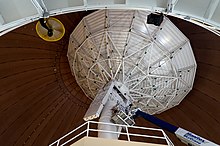
Although the U.S. Space Force is not a cyber force, it does conduct extensive cyber operations under Space Delta 6. The primary focus of Space Force cyber operations is defending U.S. Space Force networks and ensuring the operations of its spacecraft, which are controlled remotely from ground stations.[178] All space operations units have cyber squadrons assigned to defend them and incorporate offensive cyber operations.[179][180][181]
Additionally, Space Delta 6 is responsible for managing the Satellite Control Network, a global network of antennas used to communicate with the service's spacecraft. The 22nd Space Operations Squadron is responsible for overall operations, with the 21st Space Operations Squadron and 23rd Space Operations Squadron managing the ground station sites at Vandenberg Space Force Base, New Boston Space Force Station, Kaena Point Space Force Station, Diego Garcia, Guam, Greenland, and the United Kingdom.[181]
Space domain awareness
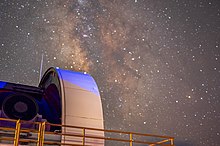
The Space Force's Space Delta 2 operates the United States Space Surveillance Network, tracking 47,000 objects in space as of 2022.[182][183] Space domain awareness encompasses the identification, characterization, and understanding of any factor associated with the space domain that could affect space operations.[174]
Space Delta 2 sensors include the AN/FPS-85 phased array radar at Eglin Air Force Base and the Space Fence radar at Kwajalein Atoll operated by the 20th Space Surveillance Squadron; and a global network of three Ground-based Electro-Optical Deep Space Surveillance telescopes operated by the 15th Space Surveillance Squadron.[184][185][186]
The 18th Space Defense Squadron, collocated with the Combined Space Operations Center, executes command and control of the Space Surveillance Network and manages the Space Catalog of all objects in Earth orbit. The 19th Space Defense Squadron focuses on objects further in cislunar space, beyond geosynchronous orbit, with a specific focus on supporting NASA's Artemis program and other human spaceflight operations.[187]
Missile warning

The Space Force's Space Delta 4 uses orbital spacecraft and ground-based radars to conduct theater and strategic missile warnings for the United States and its international partners.[188] This includes the network of Upgraded Early Warning Radars at Beale Air Force Base, Clear Space Force Station, Cape Cod Space Force Station, Pituffik Space Base, and RAF Fylingdales, along with the AN/FPQ-16 PARCS radar at Cavalier Space Force Station.[189][190] Currently, the Space Force is working with the Missile Defense Agency to acquire the Long Range Discrimination Radar at Clear Space Force Station in Alaska. These ground-based radars also contribute to the Space Surveillance Network.[191]
Space-based missile warning systems include the Defense Support Program and Space-Based Infrared System (SIBRS) spacecraft, which use infrared sensors to conduct missile defense and missile warning. SIBRS also has a battlespace awareness and technical intelligence mission.[192] The Defense Support Program spacecraft are also capable of detecting nuclear detonations, in addition to space and missile launches.[193]
Global Positioning System and military satellite communications
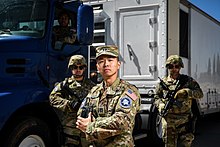
The Space Force's Space Delta 8 is the operator of the Global Positioning System and the military's array of communications spacecraft.[194]
The Global Positioning System is operated by the 2nd Space Operations Squadron, providing positioning, navigation, and timing information for civilian and military users across the entire world.[195] The Space Force's GPS system has become an integral element of the global information infrastructure, being used in virtually all sectors of the economy, including agriculture, aviation, marine transportation, surveying and mapping, and transit navigation. Its timing signal is used to synchronize global communication systems, electrical power grids, and financial networks.[196] The Global Positioning System also has a secondary mission of carrying nuclear detonation detection sensors.[197]
Military satellite communication systems include the Fleet Satellite Communications System, UHF Follow-On satellite, and Mobile User Objective System, operated by the 10th Space Operations Squadron and inherited from the U.S. Navy.[198] The payloads on the Wideband Global SATCOM and Defense Satellite Communications System are operated by the 53rd Space Operations Squadron, a role inherited from the U.S. Army.[199] Finally, spacecraft operations for the Wideband Global SATCOM and Defense Satellite Communications System are conducted by the 4th Space Operations Squadron, in addition to the Milstar and Advanced Extremely High Frequency satellites, which both additionally support command and control of strategic nuclear forces.[200][201]
Space launch

The Space Force's space launch enterprise is organized under Space Systems Command, with Space Launch Delta 30 managing the Western Range from Vandenberg Space Force Base and Space Launch Delta 45 managing the Eastern Range from Cape Canaveral Space Force Station.[202]
The Space Force does not just manage military space launches, but also supports NASA and commercial space launches.[202] Major space launch vehicles flown or scheduled to fly off of Space Force launch ranges include NASA's Space Launch System, SpaceX's Starship, Falcon Heavy, and Falcon 9, and United Launch Alliance's Vulcan, which will replace the Atlas V and Delta IV Heavy. Currently, vehicles for the National Security Space Launch program include the Vulcan, Atlas V, Falcon Heavy, and Falcon 9 rockets.[203]
An experimental Air Force Research Laboratory vanguard program that the Space Force leads, Rocket Cargo, is exploring using rockets to supplement naval and air transport to rapidly deliver supplies to forces across the Earth.[204] The SpaceX Starship rocket is one such system currently being explored.[205]
Space Force commands
The Space Force is organized into three field commands and multiple component field commands, which serve as joint force space component commands for the unified combatant commands.[206]
| Name | Mission | Headquarters | |
|---|---|---|---|
 | Headquarters Space Force (HSF) | Space Force service headquarters led by the chief of space operations. | The Pentagon, Virginia |
| Field commands | |||
 | Space Operations Command (SpOC) | The Space Force's operations field command, conducting space operations, cyberspace operations, and intelligence operations. Space Force component to United States Space Command.[207] | Peterson Space Force Base, Colorado |
 | Space Systems Command (SSC) | Conducts research, development, acquisitions, and sustainment of Space Force systems and conducts space launch operations. | Los Angeles Air Force Base, California |
 | Space Training and Readiness Command (STARCOM) | Conducts Space Force training, education, doctrine development, and testing. | Peterson Space Force Base, Colorado |
 | Space Force Element, National Reconnaissance Office (SFELM NRO) | Space Force component for the National Reconnaissance Office.[208] | Chantilly, Virginia |
 | U.S. Space Forces Indo-Pacific (USSPACEFOR-INDOPAC) | Space Force component and joint force space component command for United States Indo-Pacific Command.[209] | Joint Base Pearl Harbor–Hickam, Hawaii |
 | U.S. Space Forces Central (USSPACEFOR-CENT) | Space Force component and joint force space component command for United States Central Command. | MacDill Air Force Base, Florida |
 | U.S. Space Forces Korea (USSPACEFOR-KOR) | Space Force component and joint force space component command for United States Forces Korea. | Osan Air Base, South Korea |
U.S. Coast Guard
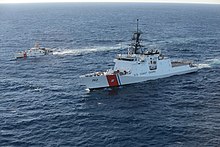
The United States Coast Guard (USCG) is the United States Armed Forces' maritime security, maritime search and rescue, and maritime law enforcement force. It was first established in 1790 as the United States Revenue-Marine and consists of the Regular Coast Guard and the Coast Guard Reserve.
Although it has always been one of the six military branches, the Coast Guard is organized under the Department of Homeland Security under the leadership of the secretary of Homeland Security and the deputy secretary of Homeland Security. During times of war, the U.S. Coast Guard can be transferred to the Department of the Navy[210] The Coast Guard itself is led by the commandant of the Coast Guard and vice commandant of the Coast Guard, both admirals advised by the master chief petty officer of the Coast Guard.[211]

The Coast Guard has six major operational mission programs, through which it executes its 11 statutory missions:[212]
- Maritime law enforcement
- Maritime response
- Maritime prevention
- Maritime transport system management
- Maritime security operations
- Defense operations
Maritime law enforcement operations focus on protecting the United States maritime borders and assuring its maritime sovereignty. The Coast Guard conducts operations to suppress violations of U.S. law at sea, including counter-illegal migration and transnational organized crime operations. Codified missions executed under the maritime law enforcement program include drug interdiction, migrant interdiction, living marine resources, and other law enforcement.[212]
Maritime response operations see the Coast Guard conducting search-and-rescue operations and rescuing mariners responding to maritime disasters. Codified missions include search and rescue and marine environmental protection (response activities).[212]
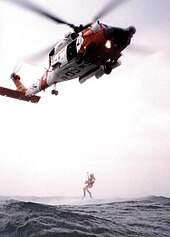
Maritime prevention operations prevent marine casualties and property losses, minimize security risks, and protect the marine environment. The Coast Guard does so by developing and enforcing federal regulations, conducting safety and security inspections, and analyzing port security risk assessments. Codified missions include ports, waterways, and coastal security, marine safety, and marine environmental protection (protection activities).[212]
Maritime transport system management ensures a safe, secure, and environmentally sound waterways system. Codified missions include maintaining aids to navigation and ice operations.[212]
Maritime security operations include activities to detect, deter, prevent, and disrupt terrorist attacks, and other criminal acts in the U.S. maritime domain. This includes the execution of anti-terrorism, response, and select recovery operations. This mission performs the operational element of the Coast Guard's Ports, Waterways, and Coastal Security mission and complements its Maritime Response and Prevention efforts. Codified missions include ports, waterways, and coastal security (response activities).[212]
Coast Guard Defense Operations deploy the Coast Guard globally under the Department of Defense's unified combatant commands, where it operates under the joint force maritime component commands. Codified missions include defense readiness.[212]
Coast Guard commands
The U.S. Coast Guard is organized into two area commands that cover the entire globe.[213]
| Name | Mission | Headquarters | |
|---|---|---|---|
 | Coast Guard Headquarters (USCG HQ) | Coast Guard service headquarters led by the commandant of the Coast Guard. | Douglas A. Munro Coast Guard Headquarters Building, Washington D.C. |
| Operating forces | |||
 | Coast Guard Atlantic Area (LANTAREA) | Conducts Coast Guard operations east of the Rocky Mountains, to include the Atlantic Ocean, Caribbean, Europe, Africa, and the Middle East. | Coast Guard Station Portsmouth, Virginia |
 | Coast Guard Pacific Area (PACAREA) | Conducts Coast Guard operations west of the Rocky Mountains, to include the Indo-Pacific region. | Coast Guard Base Alameda, California |
 | Coast Guard Cyber Command (CGCYBER) | Conducts Coast Guard cyber operations and collaborates with United States Cyber Command.[214] | Washington D.C. |
 | U.S. Coast Guard Reserve (USCGR) | Oversees and maintains Coast Guard reserve forces | Douglas A. Munro Coast Guard Headquarters Building, Washington D.C. |
Modernization and budget
Budget
The United States manages the world's largest military budget, followed by the People's Republic of China, India, United Kingdom, and Russia.[215]
The James M. Inhofe National Defense Authorization Act for Fiscal Year 2023 established the topline defense budget as $857.9 billion, with the Department of Defense receiving $816.7 billion and the Department of Energy's national security programs receiving $30.3 billion, an 8% increase from Fiscal Year 2022.[216][217]
The Department of the Air Force budget, unlike the Department of the Army or Department of the Navy has a sizable portion of "pass-through." This is money not controlled or used by the Air Force, but is instead passed to other Department of Defense agencies and can be up to 17% of the department's budget. This pass-through allocation gives the impression that the Air Force is the highest funded military department. It is actually the least funded.[218]
| Account | U.S. dollars (billions) |
|---|---|
| Procurement | |
| Research, Development, Test, & Evaluation | |
| Operations & Maintenance | |
| Military Personnel & Health | |
| Military Construction | |
| Defense-related Nuclear Programs |
| Service | U.S. dollars (billions) |
|---|---|
| Army[220] | |
| Marine Corps[221] | |
| Navy[222] | |
| Air Force[223] | |
| Space Force[224] | |
| Coast Guard[225] | |
| Defense-wide[222] |
Army modernization
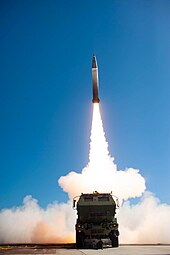
The Army's modernization efforts, led by Army Futures Command, are centralized into six priorities. Each priority is led by a Cross Functional Team.
Long Range Precision Fires is the land service's top modernization priority, focusing on rebuilding its Field Artillery Branch in response to longer range Russian and Chinese artillery systems. The Extended Range Cannon Artillery program is developing a cannon artillery piece that can accurately fire at targets 70 kilometers away, an increase from the 30 kilometer distance of current cannon artillery. The Precision Strike Missile is a surface-to-surface guided missile intended to be fired from the current M270 Multiple Launch Rocket System and M142 HIMARS, replacing their current missiles and doubling the rate of fire. The Army is also working with the Missile Defense Agency, U.S. Navy, and U.S. Air Force to develop a common hypersonic glide body, which the Army will employ as part of the mobile ground launched Long-Range Hypersonic Weapon program. Finally, the Army is working to modify the U.S. Navy's RIM-174 Standard ERAM and UGM-109 Tomahawk land attack cruise missile for ground launch to provide the Army with mid-range artillery capability.[226]
The Next Generation Combat Vehicle program is developing a family of fighting vehicles for the Armor Branch to increase firepower, speed, and survivability. The Optionally Manned Fighting Vehicle is intended to replace the M2 Bradley, while the Armored Multi-Purpose Vehicle will replace the M113 armored personnel carriers, which have been used since the Vietnam War. The three variants of the Armored Multi-Purpose Vehicle are general purpose, mission command, and medical treatment. The Mobile Protected Firepower is designed to be a light tank for Infantry Brigade Combat Teams. Finally, the Robotic Combat Vehicles are intended to come in light, medium, and heavy variants that will serve as scouts and escorts for crewed combat vehicles.[226]
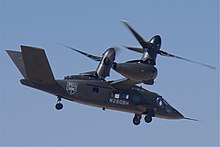
The Future Vertical Lift program is intended to replace the current helicopter fleet flown by the Army Aviation Branch.
The Future Long-Range Assault Aircraft is intended to replace the UH-60 Black Hawk and the Marine Corps UH-1Y Venom, with the Army selecting the Bell V-280 Valor tiltrotor aircraft as the winner.[227] The Future Attack Reconnaissance Aircraft is intended to replace the AH-64 Apache in the attack and reconnaissance roles.[226]
The Army is working to modernize its communication networks for the Army Signal Corps, including developing a Unified Network consisting of an integrated tactical network, an integrated enterprise network, and unified network-enabling capabilities. Other sub-efforts include developing a common operating environment, ensuring the network is interoperable with the other services and allied countries, and increasing the mobility and reducing the signature of its command posts. Efforts also include modernizing Global Positioning System technology to provide assured positioning, navigation, and timing, and working with the United States Intelligence Community and commercial space companies to increase the Army's access to space-based intelligence, surveillance, and reconnaissance capabilities.[226]

Recognizing that that United States is unlikely to have uncontested air superiority, the Army is undergoing a mass revitalization of its air and missile defense enterprise through the Air Defense Artillery Branch.
The first layer of defense is the Ballistic Low-Altitude Drone Engagement, which will be mounted on the Common Remotely Operated Weapon Station and is designed to engage small unmanned aerial vehicles. The second layer is the Multi-Mission High Energy Laser, which will intercept small drones and munitions. The third and fourth layers comprise the Maneuver Air Defense Technology and Next-Generation Fires Radar, which will be integrated into short range air defense systems. The fifth layer puts a High-Energy Laser Tactical Vehicle Demonstrator onto a Medium Tactical Vehicle, while the sixth layer encompasses the Low-Cost Extended-Range Air Defense to supplement the MIM-104 Patriot missiles.[226]
Finally, the Army is looking to improve the equipment of its soldiers in the Infantry Branch with the Next Generation Squad Weapon, the Integrated Visual Augmentation System, and the Synthetic Training Environment.[226] In 2022, the Army selected the SIG Sauer's XM7 rifle and XM250 light machine gun to replace the M4 carbine and the M249 light machine gun through the Next Generation Squad Weapon program.[228]
Marine Corps modernization
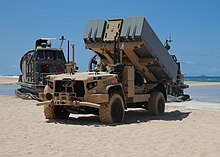
The Marine Corps modernization is being executed under the aegis of Force Design 2030, which is intended to return the service to its naval and amphibious roots serving as a "stand-in" force within contested areas of the maritime littorals.[229] As part of this effort, the Marine Corps has begun establishing naval-focused Marine Littoral Regiments, consisting of a Littoral Combat Team, Littoral Anti-Air Battalion, and a Combat Logistics Battalion. The Littoral Combat Team is organized around an infantry battalion with an anti-ship missile battery, focused on conducting sea denial operations in support of the Navy.[230]
The Marine Corps is in the process of acquiring the Amphibious Combat Vehicle, which is slated to replace the aging Assault Amphibious Vehicle. The Amphibious Combat Vehicle is intended to support the Marines during amphibious assaults and once they have reached shore. The Marine Corps has also adopted the Naval Strike Missile which is fielded from a modified Joint Light Tactical Vehicle as part of the Marines' artillery battalions. The concept is that small mobile units of Marines would move around different islands and shorelines with these weapons to fire on adversary ships.[231]
Marine Corps aviation is also in the process of acquiring the CH-53K King Stallion helicopter for heavy lift, replacing the current CH-53E Super Stallion in the role. The Marine Corps is also looking to replace its UH-1Y Venom helicopters through the Future Vertical Lift program and is in the process of acquiring a significant number of unmanned aerial vehicles, such as the MQ-9 Reaper.[231]
Navy modernization
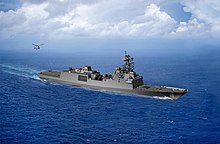
Like the Marine Corps, the Navy is in the process of overhauling and modernizing its fleet with a renewed focus. While the Navy is continuing to purchase Arleigh Burke-class destroyers, it is embarking on the DDG(X) program of guided missile destroyers to replace them and the Ticonderoga-class cruisers. The DDG(X) will include directed energy weapons and potentially hypersonic weapons.[232]
The Constellation-class frigates will be the first frigates in the U.S. Navy since the Oliver Hazard Perry-class frigates were retired. The Constellation-class frigates are based on the Italian FREMM multipurpose frigates and will replace the littoral combat ships.[233]

The Navy is starting development on the SSN(X) attack submarines, intended to replace the Virginia-class and Seawolf-class submarines. The Columbia-class submarines will begin replacing the Ohio-class ballistic missile submarines. The acquisition of the Columbia-class submarines is the first priority of the Navy.[234][233]
With Naval Aviation, the service is continuing to procure additional Gerald R. Ford-class aircraft carriers and F-35C Lightning II stealth fighters. Ultimately, the F/A-XX program is intended to produce a sixth-generation fighter to replace the legacy F/A-18E/F Super Hornets as part of the Carrier Air Wing and is using the Future Vertical Lift program to replace its fleet of SH-60 Seahawk helicopters.[234][233]
The service is also investing heavily in unmanned platforms, such as unmanned surface vehicles, using the Ghost Fleet Overlord to test the concept. It is also fielding unmanned aerial vehicles, such as the land-based MQ-4C Triton for maritime patrol and the carrier-based MQ-25A Stingray for aerial refueling, replacing the F/A-18F in the role.[233]
Air Force modernization
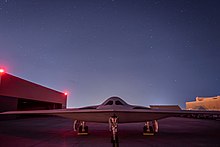
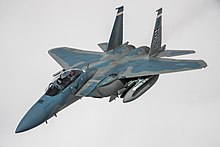
The B-21 Raider stealth bomber is the first new Air Force bomber since the B-2A Spirit. The B-21 will replace the B-2 and the B-1B Lancer, flying alongside the B-52 Stratofortress.[235] The development of the B-21 Raider was led by the Department of the Air Force Rapid Capabilities Office. The service is also developing the LGM-35 Sentinel intercontinental ballistic missile to replace the LGM-30G Minuteman IIIs.[236]
The U.S. Air Force is also in the process of developing the Next Generation Air Dominance program, which will produce a sixth generation fighter to replace the F-22 Raptor. The service is also procuring the fourth generation F-15EX Eagle II to replace the aging F-15C Eagle and F-15E Strike Eagle. It is procuring the T-7A Red Hawk trainer jet to replace the 1950s-era T-38 Talon.[235]
While not an aircraft, the Air Force is investing in developing the AIM-260 Joint Advanced Tactical Missile to replace or supplement the AIM-120 AMRAAM for its fighter forces. It is also procuring the AGM-181 Long Range Stand Off Weapon to replace the AGM-86 ALCM as a nuclear air-launched cruise missile for the B-21 Raider and the B-52 Stratofortress. The air service is investing in hypersonic weapons, with the AGM-183 Air-Launched Rapid Response Weapon, the Hypersonic Air-breathing Weapon Concept, and the Hypersonic Attack Cruise Missile in development.[235]
Space Force modernization
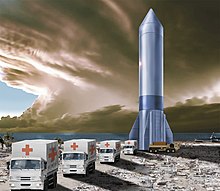
The U.S. Space Force is undergoing intensive modernization efforts. The Deep Space Advanced Radar Capability (DARC) is intended to track objects in geosynchronous orbit with three sites, one in the United States, one in the Indo-Pacific, and one in Europe.[237]

Oracle, a spacecraft developed by the Air Force Research Laboratory for the Space Force, will demonstrate technologies that the space service needs for cislunar domain awareness – tracking objects outside of geosynchronous orbit and between Earth and the Moon. The spacecraft itself will launch to an area of gravitational stability between the Earth and the Moon to conduct operations, using a wide-field sensor and a more sensitive narrow-field sensor to discover and maintain custody of objects operating in this region. Oracle will directly support NASA's Artemis program as it returns to the Moon and track potentially hazardous near-Earth objects in support of planetary defense operations.[238]
Also an Air Force Research Laboratory program for the Space Force, Arachne is the keystone experiment in the Space Solar Power Incremental Demonstrations and Research Project, which aims to prove and mature essential technologies for a prototype space-based solar power transmission system capable of powering a forward operating base. Arachne will specifically demonstrate and mature technologies related to more efficient energy generation, radio frequency forming, and radio frequency beaming. Current forward operation bases rely on significant logistics convoys to transport fuel for power – space-based solar power would move these supply lines to space, where they cannot be easily attacked. Space Force provided space-based solar power may transition to civilian use in the same vein as GPS.[239] Other space-based power beaming demonstrations include the Space Power InfraRed Regulation and Analysis of Lifetime (SPIRRAL) and Space Power INcremental DepLoyable Experiment (SPINDLE) experiments.[240]

The Navigation Technology Satellite-3 (NTS-3), building on the Space Force's Global Positioning System constellation, is an Air Force Research Laboratory spacecraft that will operate in geosynchronous orbit to test advanced techniques and technologies to detect and mitigate interference to positioning, navigation, and timing capabilities and increase system resiliency for military, civil, and commercial users. NTS-3 is a Vanguard program, described as aiming to deliver potentially game changing capabilities.[241]
The Space Force's Rocket Cargo program is another Air Force Research Laboratory Vanguard program, focused on leasing space launch services to quickly transport military materiel to ports across the globe. If proven viable, the Space Force's Space Systems Command will be responsible for transitioning it to a program of record. United States Transportation Command would be the primary user of this capability, rapidly launching up to 100 tons of cargo anywhere in the world.[204]
Personnel
This section needs to be updated. The reason given is: first paragraph and women section. (June 2024) |
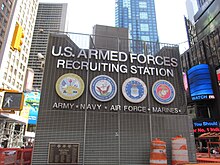

Air Force and Space Force
Marine Corps
Navy
Army
The U.S. Armed Forces is the world's third largest military by active personnel, after the Chinese People's Liberation Army and the Indian Armed Forces, consisting of 1,359,685 servicemembers in the regular armed forces with an additional 799,845 servicemembers in the reserves as of 28 February 2019.[242][needs update]
While the United States Armed Forces is an all-volunteer military, conscription through the Selective Service System can be enacted at the president's request and Congress' approval, with all males ages 18 through 25 living in the United States required to register with the Selective Service.[243] Although the constitutionality of registering only males for Selective Service was challenged by federal district court in 2019, its legality was upheld by a federal appeals court in 2020.[244]
As in most militaries, members of the U.S. Armed Forces hold a rank, either that of officer, warrant officer or enlisted, to determine seniority and eligibility for promotion. Those who have served are known as veterans. Rank names may be different between services, but they are matched to each other by their corresponding paygrade.[245] Officers who hold the same rank or paygrade are distinguished by their date of rank to determine seniority. Officers who serve in certain positions of office of importance set by law, outrank all other officers on active duty of the same rank and paygrade, regardless of their date of rank.[246]
Personnel by service
Total number of authorized personnel in FY23.[247]
| Component | Total | Active | Reserve | National Guard |
| 49,500 | 41,700 | 7,800 | ||
| 2,136,844 | 1,358,644 | 344,800 | 433,400 |
Rank structure
Rank in the United States Armed Forces is split into three distinct categories: officers, warrant officers, and enlisted personnel. Officers are the leadership of the military, holding commissions from the president of the United States and confirmed to their rank by the Senate. Warrant officers hold a warrant from the secretaries of the military departments, serving as specialists in certain military technologies and capabilities. Upon promotion to chief warrant officer 2, they gain a commission from the president of the United States. Enlisted personnel constitute the majority of the armed forces, serving as specialists and tactical-level leaders until they become senior non-commissioned officers or senior petty officers. Military ranks across the services can be compared by U.S. Uniformed Services pay grade or NATO rank code.[248]
Officer corps
Officers represent the top 18% of the armed forces, serving in leadership and command roles.[252] Officers are divided into three categories:[248]
- O-1 to O-3: Company grade officers in the Army, Marine Corps, Air Force, and Space Force or junior officers in the Navy and the Coast Guard.
- O-4 to O-6: Field grade officers in the Army, Marine Corps, Air Force, and Space Force or mid-grade officers in the Navy and Coast Guard.
- O-7 to O-10: General officers in the Army, Marine Corps, Air Force, and Space Force or flag officers in the Navy and Coast Guard.
Officers are typically commissioned as second lieutenants or ensigns with a bachelor's degree after several years of training and education or directly commissioned from civilian life into a specific specialty, such as a medical professional, lawyer, chaplain, or cyber specialist.[253][254]
- The United States Military Academy commissions officers into the United States Army.
- The United States Naval Academy commissions officers into the United States Marine Corps and United States Navy.
- The United States Air Force Academy commissions officers into the United States Air Force and United States Space Force.
- The United States Coast Guard Academy commissions officers into the United States Coast Guard.
Officers are commissioned through the United States service academies, Reserve Officer Training Corps programs, and the Officer Candidate and Officer Training Schools. During a time of war, officers may be promoted to five-star ranks, with general of the Army, fleet admiral, and general of the Air Force the only five-star ranks currently authorized.[255]
Warrant officer corps
| NATO rank | WO-5 | WO-4 | WO-3 | WO-2 | WO-1 | |||||
|---|---|---|---|---|---|---|---|---|---|---|
| Uniformed services pay grade | W-5 | W-4 | W-3 | W-2 | W-1 | |||||
| Chief warrant officer 5 | Chief warrant officer 4 | Chief warrant officer 3 | Chief warrant officer 2 | Warrant officer 1 | ||||||
| Chief warrant officer 5 | Chief warrant officer 4 | Chief warrant officer 3 | Chief warrant officer 2 | Warrant Officer 1 | ||||||
 |  |  |  |  | ||||||
| Главный прапорщик 5 | Главный прапорщик 4 | Главный прапорщик 3 | Главный прапорщик 2 | Прапорщик 1 | ||||||
| Главный прапорщик 5 | Главный прапорщик 4 | Главный прапорщик 3 | Главный прапорщик 2 | Прапорщик 1 | ||||||
 |  |  | ||||||||
| Главный прапорщик 4 | Главный прапорщик 3 | Главный прапорщик 2 | ||||||||
| звание НАТО | ВО-5 | ВО-4 | ВО-3 | ВО-2 | ВО-1 | |||||
| Размер оплаты услуг по униформе | W-5 | W-4 | W-3 | В-2 | П-1 | |||||
Прапорщики - специалисты, составляющие лишь 8% офицерского состава. [252] Прапорщики имеют ордера от своего секретаря службы и являются специалистами и экспертами в определенных военных технологиях или возможностях. Прапорщики низшего ранга служат по ордеру, но они получают поручения от президента при повышении до главного мичмана 2. Они черпают свои полномочия из того же источника, что и офицеры, но остаются специалистами, в отличие от офицеров, которые являются универсалами. . В ВВС и Космических силах нет прапорщиков. [248]
Прапорщики, как правило, до отбора являются унтер-офицерами, за исключением армейской авиации, где любой рядовой разряд может подать заявку на получение ордера. Армейские прапорщики посещают Школу кандидатов в армейские прапорщики . [256]
Рядовой корпус
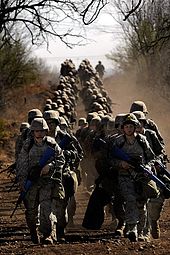
Рядовой состав составляет 82% вооруженных сил и является специалистами и тактическими руководителями. [252] Рядовой состав делится на три категории:
- От E-1 до E-3/4: Младший военнослужащий обычно проходит начальную подготовку или выполняет свое первое задание. От E-1 до E-3 в Корпусе морской пехоты, ВМФ и береговой охране и от E-1 до E-4 в армии, ВВС и Космических силах. В армии специалисты (Е-4) считаются младшими военнослужащими, а капралы (Е-4) - унтер-офицерами.
- От E-4/5 до E-6: унтер-офицеры армии, морской пехоты, военно-воздушных и космических сил, а также старшины военно-морского флота и береговой охраны. В ВВС и Космических силах Е-5 — первое унтер-офицерское звание. За тактическое руководство отвечают унтер-офицеры и старшины.
- От E-7 до E-9: старшие унтер-офицеры армии, морской пехоты, военно-воздушных и космических сил, а также старшие офицеры военно-морского флота и береговой охраны. Выполнять функции старших рядовых советников офицеров.
Ранг старшего рядового советника является высшим званием в каждой службе и является основным советником секретаря службы и начальника службы по рядовым вопросам. Прежде чем поступить на службу, военнослужащие должны пройти базовую подготовку . В Армии после прохождения базовой боевой подготовки призывники затем переходят на повышение индивидуальной подготовки по своей военно-профессиональной специальности .
После завершения подготовки новобранцев морской пехоты морские пехотинцы посещают Школу пехоты . Непехотные морские пехотинцы проходят боевую подготовку морской пехоты, прежде чем поступить в технические училища по своей военной специальности . В ВМФ после завершения подготовки новобранцев моряки переходят в свои школы класса «А» для завершения обучения для получения своего рейтинга . В ВВС и Космических силах новобранцы проходят комбинированную базовую военную подготовку, прежде чем перейти к технической подготовке по своим кодам специальности ВВС . В Береговой охране после завершения подготовки новобранцев моряки переходят в свои школы класса «А» для завершения обучения для получения своего рейтинга .
Женщины в вооруженных силах
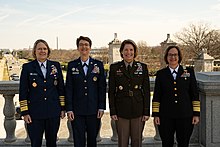

Во время Второй мировой войны женщины были завербованы во все виды вооруженных сил США. Вспомогательный женский армейский корпус был создан армией в 1942 году. В это время также были сформированы Женские летчики военно-воздушных сил ( WASP ), Женщины ВМФ, принятые в добровольные службы экстренной помощи ( WAVES ), Женский резерв корпуса морской пехоты и Береговая охрана. Женский резерв ( СПАРС ). [258] Женщины участвовали в боях во время Второй мировой войны, сначала в качестве медсестер во время нападения на Перл-Харбор 7 декабря 1941 года. В 1944 году WAC прибыли в Тихий океан и в Нормандию. Во время войны 67 армейских медсестер и 16 медсестер ВМФ были взяты в плен и провели три года в качестве японских военнопленных. Во время Второй мировой войны служило 350 000 американских женщин, 16 из которых были убиты при исполнении служебных обязанностей. В общей сложности они завоевали более 1500 медалей, почетных грамот и похвал.
После Второй мировой войны демобилизация привела к тому, что подавляющее большинство военнослужащих женщин вернулось к гражданской жизни. Закон 625, Закон о женских вооруженных силах 1948 года, был подписан президентом Гарри С. Трумэном , разрешая женщинам служить в Вооруженных силах США в полностью интегрированных подразделениях в мирное время, при этом только WAC остается отдельным женским подразделением. Во время Корейской войны 1950–1953 годов многие женщины служили в мобильных армейских хирургических госпиталях . Во время войны во Вьетнаме в составе ВВС страны служили 600 женщин, а также 500 членов ВАК и более 6000 медицинского персонала и вспомогательного персонала. Артиллерийский корпус начал принимать женщин-ракетчиков в 1974 году. [259] Члены экипажа и офицеры-женщины были приняты в полевой артиллерии . ракетные части [260] [261]
Этот раздел нуждается в дополнительных цитатах для проверки . ( июнь 2024 г. ) |
В 1974 году первые шесть женщин-летчиков ВМФ получили свое звание пилотов ВМФ. Утвержденный Конгрессом запрет на участие женщин в боевых действиях налагает ограничения на карьерный рост пилотов. [262] но по крайней мере двое ушли в отставку в качестве капитанов. [263] Роль женщин в Вооруженных силах США привлекла внимание мировых средств массовой информации во время войны в Персидском заливе 1991 года , хотя их восприятие в средствах массовой информации в этот период было искажено, поскольку мало внимания средств массовой информации уделялось ситуациям, когда женщины сталкивались с боевыми действиями. [264] [265]
В 1991 году женщинам разрешили управлять военными самолетами. С 1994 года женщинам разрешено служить на боевых кораблях США. [266] В 2010 году был снят запрет на службу женщин на подводных лодках. [267]
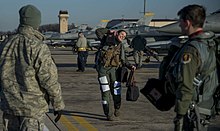
3 декабря 2015 года министр обороны США Эштон Картер объявил, что все военные боевые должности станут доступны женщинам. [268] Это дало женщинам доступ примерно к 10% военных должностей, которые ранее были для них закрыты. [269] Эти ограничения были подтверждены исследованиями, которые пришли к выводу, что смешанные гендерные подразделения менее боеспособны. [270] Различным военным службам было дано время до января 2016 года, чтобы подготовить планы относительно того, как они будут обеспечивать изменение политики. [271] Многие женщины считали, что это позволит им улучшить свои позиции в армии, поскольку большинство высокопоставленных офицеров начинают с боевых должностей. [ нужна ссылка ] Проект регистрации женщин был рекомендован Национальной комиссией по военной, национальной и государственной службе и был предложен, но так и не реализован. [272] [273] [274]
Ни одна женщина никогда не становилась морским котиком . [275] [276] Однако в июле 2021 года первая женщина окончила программу подготовки военно-морских сил специального назначения (NSW) и стала членом экипажа боевого корабля специального назначения (SWCC). SWCC напрямую поддерживает SEAL и другие подразделения спецназа и является экспертом в тактике тайного внедрения и эвакуации специальных операций. [277] [278]
Несмотря на опасения по поводу гендерного разрыва, весь персонал, как мужчины, так и женщины, одного и того же звания и стажа, получает одинаковую оплату труда во всех отраслях. [279] 1 июня 2022 года адмирал Линда Л. Фэган приняла на себя командование береговой охраной США , став не только первой женщиной, занявшей пост коменданта береговой охраны, но и первой женщиной в американской истории, занявшей должность начальника службы в США. Военный. [280]
Исследование, проведенное корпорацией RAND, показывает, что женщины, сделавшие карьеру в армии, имеют более высокие показатели продвижения по службе. [281]
Согласно отчету Министерства обороны о сексуальном насилии в армии США за 2019 финансовый год, было зарегистрировано 7825 случаев. Это на 3% больше, чем в отчете за 2018 год. [282] [283]
По состоянию на 2022 год в армии служат 228 966 женщин, что составляет 17,5% от общей численности действительной военной службы. С 2021 года доля женщин на действительной службе увеличилась незначительно – на 0,3%. С 2005 года численность женщин действительной военной службы увеличилась на 2,9%. [284] [285]
Порядок приоритета
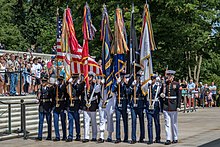
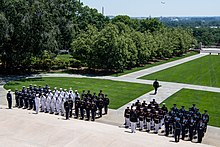
Согласно постановлению Министерства обороны, различные компоненты Вооруженных сил США имеют установленный порядок старшинства. [286] Примеры использования этой системы включают показ служебных флагов и размещение солдат, морских пехотинцев, матросов, летчиков, стражей и береговой охраны в строю.
- Курсанты Военной академии США
- Гардемарины Военно-морской академии США
- Курсанты Академии ВВС США.
- Курсанты Академии береговой охраны США.
- Гардемарины, Академия торгового флота США
- Армия США
- Корпус морской пехоты США
- ВМС США
- ВВС США
- Космические силы США
- Береговая охрана США
- Армия Национальной гвардии
- Резерв армии США
- Резерв Корпуса морской пехоты США
- Резерв ВМС США
- Воздушная Национальная гвардия
- Резерв ВВС США
- Резерв береговой охраны США
- Другие учебные и вспомогательные организации армии, морской пехоты, торгового флота , гражданского воздушного патруля и вспомогательной береговой охраны , как указано в предыдущем приказе.
Хотя ВМС США старше Корпуса морской пехоты, [287] Корпус морской пехоты имеет приоритет из-за предыдущих несоответствий в дате рождения ВМФ. Корпус морской пехоты более последовательно признавал наблюдаемую дату рождения. Считается, что Второй Континентальный конгресс учредил военно-морской флот 13 октября 1775 года, разрешив покупку кораблей, но фактически не принял «Правила регулирования военно-морского флота Соединенных колоний» до 27 ноября 1775 года. [288] Корпус морской пехоты был создан актом Второго Континентального конгресса 10 ноября 1775 года. Военно-морской флот официально не признавал 13 октября 1775 года датой своего рождения до 1972 года, когда тогдашний начальник военно-морских операций адмирал Эльмо Зумвальт разрешил наблюдать за ним как такой. [287]
Береговая охрана обычно располагается после Космических сил, но если она переводится в Военно-морское ведомство, то ее место в порядке старшинства меняется на положение после ВМФ и перед ВВС. [287]
См. также
- Сеть американских сил
- Награды и награды Вооружённых Сил США.
- Доминирование полного спектра
- Список американских военных объектов
- Список известных дислокаций вооруженных сил США за рубежом с 1798 года
- Список военной техники США
- Список действующих военных самолетов США
- Список действующей в настоящее время военной наземной техники США
- Список действующих в настоящее время военных гидроциклов США
- Военное выражение
- Временная армия США
- Групповое страхование жизни военнослужащих
- Сексуальная ориентация и гендерная идентичность в армии США
- Звезды и полосы (газета)
- Силы государственной обороны
- Единый кодекс военной юстиции
- Военные потери США в войне
- Самоубийство ветерана вооруженных сил США
- Женщины в армии США
- Женщины в Корпусе морской пехоты США
- Женщины в ВМС США
- Женщины в ВВС США
- Женщины в Космических силах США
- Женщины в береговой охране США
Примечания
Цитаты
- ^ «Общие вопросы о приемлемости и требованиях» . Goarmy.com . Архивировано из оригинала 10 ноября 2023 года . Проверено 10 ноября 2023 г.
- ^ «Общие требования» . Marines.com . Архивировано из оригинала 10 ноября 2023 года . Проверено 10 ноября 2023 г.
- ^ «Вступай в ряды ВВС» . Airforce.com . Архивировано из оригинала 10 ноября 2023 года . Проверено 10 ноября 2023 г.
- ^ «Присоединяйтесь как зачисленный» . Spaceforce.com . Архивировано из оригинала 10 ноября 2023 года . Проверено 10 ноября 2023 г.
- ^ «Береговая охрана устраняет барьеры для ускорения набора кадров» . МояКГ . Архивировано из оригинала 8 июня 2023 года . Проверено 10 ноября 2023 г.
- ^ «О выборочной службе» .
- ^ «NDAA на 2023 финансовый год: EndStrength активных компонентов» . 23 августа 2022 г. Проверено 15 февраля 2023 г.
- ^ «Комитет по ассигнованиям опубликовал законопроект о финансировании обороны на 2022 финансовый год» . 29 июня 2021 года. Архивировано из оригинала 12 октября 2023 года . Проверено 3 августа 2021 г.
- ^ «Байден подписывает Закон о полномочиях национальной обороны» .
- ^ «Оборонные расходы стран НАТО (2012–2022 гг.)» (PDF) . Отдел общественной дипломатии НАТО. 27 июня 2022 г. Проверено 13 марта 2023 г.
- ^ Перейти обратно: а б «TIV импорта/экспорта оружия из США, 2014–2022 гг.» . Стокгольмский международный институт исследования проблем мира . 26 января 2024 г.
- ^ «Парламент Ирана одобряет законопроект, объявляющий армию США «террористической» » . Аль Джазира . Проверено 23 июля 2024 г.
- ^ Как указано на официальном веб-сайте ВМС США, архивировано 29 июня 2011 года на Wayback Machine , слово «вооруженные силы» пишется с заглавной буквы, если перед ним стоят «Соединенные Штаты» или «США».
- ^
- ^ Гарамоне, Джим (20 декабря 2019 г.). «Трамп подписал закон о создании космических сил США» . Министерство обороны США . Проверено 21 декабря 2019 г.
- ^ Перейти обратно: а б с «Наши силы» . Министерство обороны США .
- ^ Перейти обратно: а б «ДИРЕКТИВНЫЕ функции Министерства обороны и его основные компоненты» (PDF) . Министерство обороны . 17 сентября 2020 г. Проверено 8 августа 2023 г.
- ^ Киннард, Дуглас. «Министр обороны в ретроспективе». Министр обороны. Лексингтон: Университет Кентукки, 1980. 192–93. Распечатать.
- ^ О'Салливан, Майкл; Субраманиан, Критика (17 октября 2015 г.). Конец глобализации или более многополярный мир? (Отчет). Кредит Свисс АГ. Архивировано из оригинала 15 февраля 2018 года . Проверено 14 июля 2017 г.
- ^ «Тенденции военных расходов на 2023 год» (PDF) . Стокгольмский международный институт исследования проблем мира . Апрель 2024 года . Проверено 22 апреля 2024 г.
- ^ «Министерство обороны | Отчет о базовой структуре | Базовый показатель за 2015 финансовый год» (PDF) . 5 сентября 2015 г. Архивировано из оригинала (PDF) 5 сентября 2015 г. . Проверено 18 октября 2017 г.
- ^ « 15 увлекательных фактов об Америке, которые вы никогда не знали» – читательский дайджест» . rd.com. Архивировано из оригинала 1 апреля 2017 года . Проверено 11 апреля 2017 г.
- ^ «Организация и управление береговой охраны, глава первая» . Архивировано из оригинала 3 ноября 2013 года . Проверено 7 октября 2013 г.
- ^ Перейти обратно: а б «Армия США | Первое национальное учреждение Америки» . Армия США | Первое национальное учреждение Америки . Проверено 18 апреля 2022 г.
- ^ Перейти обратно: а б «Рождение ВМС США» . Командование военно-морской истории и наследия США . Архивировано из оригинала 9 февраля 2023 года . Проверено 23 мая 2023 г.
- ^ «Университет морской пехоты > Исследования > Отдел истории корпуса морской пехоты > Часто запрашиваемые темы > Исторические документы, приказы и речи > Резолюция о создании континентальной морской пехоты» . www.usmcu.edu . Проверено 18 апреля 2022 г.
- ^ «Университет морской пехоты > Исследования > Отдел истории корпуса морской пехоты > Краткие истории > Краткая история Корпуса морской пехоты США» . www.usmcu.edu . Проверено 18 апреля 2022 г.
- ^ «Власть объявлять войну | Палата представителей США: история, искусство и архивы» . History.house.gov . Проверено 18 апреля 2022 г.
- ^ «Временная шкала 1700–1800» . www.history.uscg.mil . Проверено 19 апреля 2022 г.
- ^ «Хронология 1900-х – 2000-х годов» . www.history.uscg.mil . Проверено 19 апреля 2022 г.
- ^ «История ВВС» . Новости ВВС . 21 ноября 2017 года . Проверено 19 апреля 2022 г.
- ^ «Предпочтение ветеранам и службе «военного времени» . 15 августа 2016 года. Архивировано из оригинала 21 июня 2018 года . Проверено 20 ноября 2018 г.
- ^ Отт, Алан (9 января 2023 г.). «Букварь по обороне: военные кафедры» . Исследовательская служба Конгресса . Проверено 4 июля 2024 г.
- ^ «Страница Космических сил США в Facebook» . Фейсбук . 20 декабря 2019 г.
- ^ «О Командовании космических операций» . Spoc.SpaceForce.mil . Проверено 18 апреля 2022 г.
- ^ Версии отчета № R42738 , Исследовательская служба Конгресса США.
- ^ «Вторая статья Конституции США» . Национальный конституционный центр – Вторая статья Конституции США . Проверено 21 апреля 2022 г.
- ^ «Оперативные и вспомогательные компоненты | Национальная безопасность» . www.dhs.gov . Проверено 27 апреля 2022 г.
- ^ «Организация и управление Министерством обороны» (PDF) . Проверено 18 апреля 2022 г.
 В данную статью включен текст из этого источника, находящегося в свободном доступе .
В данную статью включен текст из этого источника, находящегося в свободном доступе . - ^ «Таблица ключевых лидеров Министерства обороны» (PDF) .
- ^ «Пришло время береговой охране присоединиться к Объединенному комитету начальников штабов» . Военно-морской институт США . 1 августа 2020 г.
- ^ «Совет национальной безопасности» . Белый дом . Проверено 20 апреля 2022 г.
- ^ «Действующий советник по национальной безопасности: мифы и опасения» . Война на камнях . 28 февраля 2017 г. Проверено 20 апреля 2022 г.
- ^ Геллер, Эрик (июнь 2018 г.). «Трамп назначил чиновника Береговой охраны новым советником по внутренней безопасности» . Политик . Проверено 21 апреля 2022 г.
- ^ «Меморандум об обновлении системы Совета национальной безопасности» . Белый дом . 5 февраля 2021 г. Проверено 20 апреля 2022 г.
- ^ «Указ о Национальном космическом совете» . Белый дом . 1 декабря 2021 г. Проверено 21 апреля 2022 г.
- ^ «Совместная публикация 1: Доктрина вооруженных сил США» (PDF) . Объединенный комитет начальников штабов вооруженных сил США. 25 марта 2013 г. Архивировано из оригинала (PDF) 28 октября 2021 г. . Проверено 28 сентября 2021 г.
- ^ "О" . Стратегическое командование США . Архивировано из оригинала 4 октября 2023 года.
- ^ «Агенства боевой поддержки (CSA)» (PDF) . Министерство обороны . 27 июня 2013 г. 3000.06 . Проверено 8 августа 2023 г.
- ^ "О нас" . Агентство по управлению оборонными контрактами . Архивировано из оригинала 11 октября 2023 года.
- ^ «Готовность и боевое обеспечение» . Военная система здравоохранения . Архивировано из оригинала 11 октября 2023 года.
- ^ «Наша работа» . Агентство оборонных информационных систем . Архивировано из оригинала 27 ноября 2023 года.
- ^ «О АСВ» . www.dia.mil .
- ^ «Об Агентстве оборонной логистики» . www.dla.mil .
- ^ "О нас" . www.dtra.mil .
- ^ «О нас | Национальное агентство геопространственной разведки» . www.nga.mil .
- ^ «Агентство национальной безопасности/Служба центральной безопасности > О нас > Служба центральной безопасности» . www.nsa.gov .
- ^ «Миссия и боевое обеспечение Агентства национальной безопасности» . www.nsa.gov .
- ^ «Видение и стратегия армии | Армия США» . Видение и стратегия армии | Армия Соединенных Штатов .
- ^ «Официальная домашняя страница армии США» . www.army.mil .
- ^ Перейти обратно: а б «ADP1: Армия» (PDF) . Армия США.
 В данную статью включен текст из этого источника, находящегося в свободном доступе .
В данную статью включен текст из этого источника, находящегося в свободном доступе . - ^ Перейти обратно: а б с д и ж г час я дж к л м н тот п д р с т в v В х и С аа аб и объявление но из в «ДоДИ 5100.01» (PDF) . Министерство обороны США.
 В данную статью включен текст из этого источника, находящегося в свободном доступе .
В данную статью включен текст из этого источника, находящегося в свободном доступе . - ^ «Пройдет немало времени, прежде чем солдаты получат замену М4 и пиле» . 20 апреля 2022 г.
- ^ «101-я воздушно-десантная дивизия (десантно-штурмовая) :: ФОРТ КЭМПБЕЛЛ» .
- ^ «XVIII воздушно-десантный корпус:: Форт-Брэгг» .
- ^ «Подготовка по ведению боевых действий в горах получила твердую десятку!» . 23 февраля 2021 г.
- ^ «Курс обучения операциям в джунглях бросает вызов умственной и физической готовности» . 3 июля 2017 г.
- ^ Перейти обратно: а б «Силовая структура» (PDF) . bening.army.mil . Архивировано из оригинала (PDF) 27 февраля 2023 года . Проверено 27 февраля 2023 г.
- ^ «Армейские рейнджеры» .
- ^ «Домашняя страница 75-го полка рейнджеров» . www.soc.mil .
- ^ "ФН СКАР!" . СОФРЕП . Архивировано из оригинала 27 февраля 2023 года . Проверено 27 февраля 2023 г.
- ^ Перейти обратно: а б «Спецназ» .
- ^ «Что значит быть частью армейского спецназа» . 8 февраля 2022 г.
- ^ «Офицер бронетехники» .
- ^ «Броневая ветка тройного сложения» (PDF) . bening.army.mil . Архивировано из оригинала (PDF) 27 февраля 2023 года . Проверено 27 февраля 2023 г.
- ^ «Кадеты | Офис разработчиков полевой артиллерии (FAPO) | Форт Силл | Оклахома | Центр передового опыта в области пожарной безопасности» .
- ^ «Король битвы полевой артиллерии» (PDF) . tradocfcoeccafcoepfwprod.blob.core.usgovcloudapi.net .
- ^ «Армия США | Историческая информация об арсенале Редстоун» .
- ^ « Уверенная в достижении цели на 2023 год, армия называет гиперзвуковое оружие «Темным орлом» » . 11 августа 2021 г.
- ^ «Первое подразделение получит армейскую гиперзвуковую ракету в 2023 году» . Январь 2023 г.
- ^ «Армия возрождает артиллерийское командование в Европе» . 3 ноября 2021 г.
- ^ Перейти обратно: а б с «OCADA | Форт Силл | Оклахома | Центр передового опыта в области пожарной безопасности» .
- ^ «Командование противовоздушной и противоракетной обороны 32-й армии» .
- ^ «100-я бригада противоракетной обороны» .
- ^ «Хронологический обзор 60 лет» (PDF) . smdc.army.mil .
- ^ «Перестройка структуры ПВО» . АУСА . 23 июня 2021 г.
- ^ "Обнаружить" . 27 октября 2016 г.
- ^ «Современная авиация – авиация армии США» .
- ^ «Беспилотный авиационный комплекс (БПЛА) MQ-1C Grey Eagle – USAASC» .
- ^ «160-я страница SOAR (A)» .
- ^ «Организация | Армия США» . Организация | Армия Соединенных Штатов .
- ^ «Командование вооруженных сил США | FORSCOM» . www.army.mil .
- ^ «Командование материальной частью армии США | Армия США» . www.army.mil .
- ^ «О программе – Доктрина обучения и командование армии США» . www.tradoc.army.mil .
- ^ «Фьючерсы | Армия США» . www.army.mil .
- ^ Перейти обратно: а б «Корпус» . www.marines.mil .
- ^ Перейти обратно: а б Харкинс, Джина (9 января 2020 г.). « Силы морской пехоты флота вернулись, поскольку комендант настаивает на возвращении к военно-морским корням» . Military.com .
- ^ Перейти обратно: а б с д «Морская воздушно-наземная оперативная группа | МАГТФ | Морская пехота» .
- ^ «Все винтовки морской пехоты М27 в наличии — если вы не грубый солдат и не работаете с ними, вы их не получите» . 21 апреля 2019 г.
- ^ «Морские пехотинцы и санитары ВМФ проходят полевые учения по оказанию помощи раненым в Форт-Маккой» .
- ^ «Стареющий LAV морской пехоты все еще используется в Корпусе… И теперь он также является музейным экспонатом» . 7 января 2019 г.
- ^ «Роли наземного боя» .
- ^ «То, как Корпус морской пехоты перейдет на дальние дистанции, может изменить его сильные артиллерийские традиции» . 9 апреля 2021 г.
- ^ «Вот как изменится авиация морской пехоты в соответствии с авиационным планом Корпуса на 2022 год» . 11 мая 2022 г.
- ^ «Корпус морской пехоты готов нанести удар по самолетам и дронам противника» . 3 февраля 1984 г.
- ^ «Кто мы» . Архивировано из оригинала 26 февраля 2023 года . Проверено 26 февраля 2023 г.
- ^ «И Информационная группа МЭФ» .
- ^ «I Морской Экспедиционный Корпус > Части > I МИГ > 1-й РАДИО БН» .
- ^ «Морской Приморский Полк (МЛР)» . Флагман Корпуса морской пехоты США . [ постоянная мертвая ссылка ]
- ^ «Морские рейдеры: единственное подразделение специального назначения корпуса» .
- ^ "О" . www.marforcom.marines.mil .
- ^ «Силы морской пехоты США в Тихом океане – обеспечение свободного и открытого Индо-Тихоокеанского региона» . www.marforpac.marines.mil .
- ^ «Системное командование морской пехоты: оснащение нашей морской пехоты» . www.marcorsyscom.marines.mil .
- ^ «Миссия» . www.marforres.marines.mil .
- ^ Перейти обратно: а б "О" . www.navy.mil .
- ^ «Морская война 2010–2020: сравнительный анализ» . 6 августа 2020 г.
- ^ «Наземная война» . www.usna.edu .
- ^ «Авианосцы – CVN» . www.navy.mil .
- ^ «Корабельные боевые силы» . nvr.navy.mil .
- ^ «Подводные лодки, авианосцы, крейсеры и другие суда | Navy.com» . www.navy.com .
- ^ «Отчет Конгрессу о программе фрегатов класса Constellation (FFG-62)» . 27 декабря 2022 г.
- ^ «Размер флота» . nvr.navy.mil .
- ^ «Воинские части: Военно-Морской Флот» . Министерство обороны США .
- ^ «Это видео демонстрирует мощь подводных сил ВМС США» . 31 марта 2018 г.
- ^ «Подводные лодки» . www.usna.edu .
- ^ «Подводные лодки с баллистическими ракетами | Командующий подводными силами Тихоокеанского флота США» . www.csp.navy.mil .
- ^ «Подводные лодки с управляемыми ракетами | Командующий подводными силами Тихоокеанского флота США» . www.csp.navy.mil .
- ^ Перейти обратно: а б с «Авиационная война» . www.usna.edu .
- ^ «Стратегические коммуникации Крыло 1» . www.airpac.navy.mil .
- ^ «Миссия» . www.usff.navy.mil . Архивировано из оригинала 26 февраля 2023 года . Проверено 26 февраля 2023 г.
- ^ "О нас" . www.af.mil .
- ^ «Концепция будущей эксплуатации ВВС: взгляд на ВВС в 2035 году» (PDF) . airforcemag.com . Сентябрь 2015 года . Проверено 28 сентября 2021 г.
- ^ «Объединенная команда» (PDF) . доктрина.af.mil .
- ^ «Обеспечение возвышенности» (PDF) . airandspaceforces.com .
- ^ «Ф-22 Раптор» .
- ^ «Если Конгресс заблокирует вывод F-22 из эксплуатации, ожидайте воздействия на программы беспилотников ВВС: Хантер» . 16 августа 2022 г.
- ^ «Ф-35А Лайтнинг II» .
- ^ «F-35 завершает финальные испытания ядерного оружия серии B61» . 5 октября 2021 г.
- ^ «Ф-15 Игл» .
- ^ «F-15E Страйк Игл» .
- ^ «F-15EX может заменить флот Strike Eagle в дополнение к старым моделям C/D, заявляют ВВС США» . 30 июля 2020 г.
- ^ «F-16 Файтинг Фалкон» .
- ^ «Ядерная миссия в один конец» .
- ^ «А-10С Тандерболт II» .
- ^ Перейти обратно: а б «Б-2 Спирит» .
- ^ «Б-21 Рейдер» .
- ^ «Б-52Н Стратофортресс» .
- ^ «LGM-30G Минитмен III» .
- ^ «МБР Sentinel «на ходу» для летных испытаний в этом году: старший представитель ВВС США» . 16 февраля 2023 г.
- ^ «AC-130J Призрачный гонщик» .
- ^ «MC-130J Коммандос II» .
- ^ «CV-22 Оспри» .
- ^ «Боевой спасательный вертолет сокращает перерасход средств, - заявляют ВВС» . 12 августа 2022 г.
- ^ «MQ-9 Жнец» .
- ^ «Миссия» .
- ^ «Е-3 Сентри (ДРЛО)» .
- ^ «Вступительное слово генерала Минихана для A/TA 2021» .
- ^ «С-5М Супер Гэлакси» .
- ^ «С-17 Глоубмастер III» .
- ^ «С-130 Геркулес» .
- ^ «ВК-25 – Air Force One» .
- ^ «КС-46А Пегас» .
- ^ «Стратотанкер КС-135» .
- ^ «Основные командования и резервные компоненты» (PDF) . airforcemag.com . 30 сентября 2012 года . Проверено 28 сентября 2021 г.
- ^ "О нас" . www.acc.af.mil .
- ^ «Командование авиационного образования и подготовки > О нас» . www.aetc.af.mil .
- ^ "О" . www.afgsc.af.mil .
- ^ "О нас" . www.afmc.af.mil .
- ^ "О нас" . www.afsoc.af.mil .
- ^ «Вступительное слово генерала Минихана для A/TA 2021» . www.amc.af.mil .
- ^ «Наша история – Космические силы США» . www.spaceforce.com .
- ^ «Лидерство» . www.spaceforce.mil .
- ^ Перейти обратно: а б с «Космические силы выпускают первую доктрину, определяющую «космическую мощь» как отдельную форму военной мощи» . Космические силы США . 10 августа 2020 г.
- ^ «Осведомленность о космической сфере и боевая мощь» .
- ^ «Space Delta 9 создает орбитальные боевые корабли с нуля» . База космических сил Шривер (в архиве) . [ постоянная мертвая ссылка ]
- ^ «Космическая Дельта 3 фокусируется на электромагнитном спектре» . Космическое командование США . [ постоянная мертвая ссылка ]
- ^ «Вступая в четвертый год, Космические силы уделяют особое внимание кибервозможностям» .
- ^ «Космические силы борются с угрозами кибербезопасности» . 7 июля 2022 г.
- ^ «Космические силы внедряют киберэскадрилии в дельта-миссии» . 11 октября 2022 г.
- ^ Перейти обратно: а б «План Космических сил для кибервоинов» . 29 мая 2020 г.
- ^ «Космическое командование США передаст отслеживание космических объектов Министерству торговли» .
- ^ «Космическая Дельта-2 наблюдает за дальним космосом» . База ВВС Неллис .
- ^ «Главная эскадрилья космического наблюдения, расположенная в Эглине» . 12 декабря 2011 г.
- ^ «Космический забор» . 7 марта 2023 г.
- ^ «Наземное электрооптическое наблюдение за дальним космосом» . Архивировано из оригинала 4 марта 2023 года . Проверено 4 марта 2023 г.
- ^ «Космические силы завершают структуру Дельты-2» . 4 мая 2022 г.
- ^ «Космическая Дельта 4» . Архивировано из оригинала 21 марта 2023 года . Проверено 26 февраля 2023 г.
- ^ «Все пять модернизированных радаров раннего предупреждения завершили обновление аппаратного и программного обеспечения второго поколения» . raytheonmisslesanddefense.com . 19 сентября 2022 года. Архивировано из оригинала 2 октября 2022 года.
- ^ «Система определения характеристик радиолокационной атаки по периметру» . Космическое командование ВВС (в архиве) . [ постоянная мертвая ссылка ]
- ^ «Радар дискриминации дальнего действия (LRDR), Станция Clear Space Force (CSFS), Аляска» (PDF) . мда.мил .
- ^ «СБИРС» . 9 августа 2022 г.
- ^ «Спутники программы поддержки обороны» .
- ^ «Космическая Дельта 8» . www.schriver.spaceforce.mil . Архивировано из оригинала 26 февраля 2023 года . Проверено 26 февраля 2023 г.
- ^ «Глобальная система позиционирования» .
- ^ «GPS.gov: Приложения для измерения времени» . www.gps.gov .
- ^ «NNSA обеспечивает надежные возможности обнаружения ядерных взрывов космического базирования» .
- ^ «10-я эскадрилья космических операций» .
- ^ «53-я эскадрилья космических операций» .
- ^ «4-я эскадрилья космических операций» .
- ^ «Усовершенствованная сверхвысокочастотная система (AEHF)» . Архивировано из оригинала 4 марта 2023 года . Проверено 4 марта 2023 г.
- ^ Перейти обратно: а б «Гарантированный доступ в космос» .
- ^ «Запуск национальной безопасности в переходный период, поскольку Космические силы ждут Вулкана» . 19 августа 2021 г.
- ^ Перейти обратно: а б «РАКЕТНЫЕ ГРУЗЫ ДЛЯ ГЛОБАЛЬНОЙ ЛОГИСТИКИ – Научно-исследовательская лаборатория ВВС» .
- ^ «SpaceX подписывает соглашение о ракетной отправке военных грузов по всему миру» .
- ^ «Космические войска начинают переход к полевой организационной структуре» . Космические силы США . 24 июля 2020 г.
- ^ «О Командовании космических операций» . www.spoc.spaceforce.mil .
- ^ «Генерал-майор Кристофер С. Повак» (PDF) . nro.gov .
- ^ «Космические силы передают силы Индо-Тихоокеанскому командованию США» . Космические силы США . [ постоянная мертвая ссылка ]
- ^ «14 Кодекса США § 103 – Департамент, в котором действует Береговая охрана» . ЛИИ/Институт правовой информации .
- ^ «Береговая охрана США – всегда готова» . www.uscg.mil .
- ^ Перейти обратно: а б с д и ж г «О миссиях береговой охраны США» . Uscg.mil .
 В данную статью включен текст из этого источника, находящегося в свободном доступе .
В данную статью включен текст из этого источника, находящегося в свободном доступе . - ^ «Береговая охрана США > Подразделения > Организация» . www.uscg.mil .
- ^ «CYBER 101: Киберкомандование береговой охраны США (CGCYBER)» . Киберкомандование США . [ постоянная мертвая ссылка ]
- ^ «Рейтинг: 10 крупнейших стран по военным расходам» . 18 августа 2022 г.
- ^ «Краткое содержание Закона о полномочиях национальной обороны на 2023 финансовый год» (PDF) . Arm-services.senate.gov .
- ^ «Конгресс санкционирует увеличение оборонного бюджета на 8%» . 16 декабря 2022 г.
- ^ «Конгресс должен прекратить вводящую в заблуждение бюджетную практику Министерства Обороны и положить конец практике сквозного финансирования» . afa.org .
- ^ Кордесман, Энтони Х. (7 декабря 2022 г.). «Стратегия и Закон Конгресса о полномочиях национальной обороны на 2023 финансовый год» .
- ^ «Армия США выполнила запрос на 185,5 миллиардов долларов на 24 финансовый год и сохранила портфель разработки оружия» . 13 марта 2023 г.
- ^ «При бюджете в 255 миллиардов долларов ВМС отдают приоритет трем подводным лодкам и гиперзвуковым кораблям, отказываясь от закупок амфибий» . 13 марта 2023 г.
- ^ Перейти обратно: а б «Канцелярия заместителя министра обороны (контролер/главный финансовый директор, март 2023 г.» (PDF) . comptroller.defense.gov .
- ^ «ВВС предлагают застой рабочей силы, летное время в бюджете на 24 финансовый год» . 13 марта 2023 г.
- ^ «Бюджет Космических сил США в предложении на 2024 год достигнет 30 миллиардов долларов» . 13 марта 2023 г.
- ^ «Береговая охрана США» (PDF) . dhs.gov .
- ^ Перейти обратно: а б с д и ж «Готовность и модернизация армии в 2022 году» . АУСА . 15 июня 2022 г. Проверено 8 августа 2023 г.
- ^ «Bell V-280 Valor только что выиграл самый важный конкурс армейских вертолетов за 40 лет» . Форбс .
- ^ «Отрядное оружие следующего поколения готово к 2023 году» . 10 октября 2022 г.
- ^ «Анализ крупнейших изменений в обновлении Marine Corps Force Design 2030» . 14 июня 2022 г.
- ^ «Морской Приморский Полк (МЛР)» .
- ^ Перейти обратно: а б «Главные новости 2022 года: приобретение Корпуса морской пехоты США» . 22 декабря 2022 г.
- ^ «Военно-морской флот уходит в соответствии с требованиями DDG (X)» .
- ^ Перейти обратно: а б с д «Главные новости 2022 года: приобретение ВМС США» . 26 декабря 2022 г.
- ^ Перейти обратно: а б «Состоялась церемония закладки первой подводной лодки с баллистическими ракетами класса «Колумбия»» .
- ^ Перейти обратно: а б с «Крупнейшие программы модернизации ВВС США | Сеть Aviation Week» .
- ^ «Первая миссия бомбардировщика-невидимки B-21: обход бюрократической волокиты Пентагона» . 10 января 2023 г.
- ^ «Космические силы заявляют, что программное обеспечение DARC работает правильно, учитывая опасения GAO» . 16 июня 2022 г.
- ^ «ОРАКЛ – Научно-исследовательская лаборатория ВВС» .
- ^ «АРАХНА – Научно-исследовательская лаборатория ВВС» .
- ^ «КОСМИЧЕСКОЕ ИЗЛУЧЕНИЕ ЭНЕРГИИ – Исследовательская лаборатория ВВС» .
- ^ «СПУТНИК НАВИГАЦИОННЫХ ТЕХНОЛОГИЙ – 3 (НТС-3) – Научно-исследовательская лаборатория ВВС» . Архивировано из оригинала 5 марта 2023 года . Проверено 5 марта 2023 г.
- ^ «Персонал Министерства обороны, отчеты и публикации о рабочей силе» . dmdc.osd.mil . Центр данных о кадрах Минобороны. Архивировано из оригинала 10 марта 2017 года . Проверено 7 мая 2019 г.
- ^ «Краткие факты и цифры» . Sss.gov . Архивировано из оригинала 12 июня 2018 года . Проверено 17 октября 2017 г.
- ^ МакГилл, Кевин (13 августа 2020 г.). «Федеральный апелляционный суд: призыв только для мужчин является конституционным» . Ассошиэйтед Пресс . Проверено 13 сентября 2020 г.
- ^ Например, генерал-лейтенант ВВС приравнивается к вице-адмиралу ВМФ, поскольку оба они имеют зарплату О-9.
- ^ «Инструкция Министерства обороны 1310.01: Звания и старшинство офицеров» (PDF) . Министерство обороны США . 6 мая 2006 г. Архивировано из оригинала (PDF) 26 октября 2011 г. . Проверено 9 ноября 2011 г.
- ^ «Бюджетный запрос Министерства обороны США на 2024 финансовый год» (PDF) . Канцелярия заместителя министра обороны . Март 2023 года . Проверено 8 августа 2023 г.
- ^ Перейти обратно: а б с «Знак отличия воинских званий США» . Министерство обороны США .
- ^ Перейти обратно: а б «Звания армии США» . армия.мил . Армия Соединенных Штатов . Проверено 27 мая 2021 г.
- ^ Перейти обратно: а б «Ряды» . морские пехотинцы.мил . Корпус морской пехоты США . Проверено 13 июня 2021 г.
- ^ Перейти обратно: а б с д и ж г «Знак отличия воинских званий США» . Defense.gov . Министерство обороны . Проверено 13 января 2022 г.
- ^ Перейти обратно: а б с «Военная карьера: Справочник по профессиональным перспективам:: Бюро статистики труда США» . www.bls.gov .
- ^ «Стать офицером — современная армия» . www.todaysmilitary.com .
- ^ Ремпфер, Кайл (17 августа 2020 г.). «Прямые заказы для армейских кибер-офицеров наконец-то набирают обороты, — говорит «две звезды»» . Армейские времена .
- ^ «Это 9 генералов, заслуживших пять звезд» . 28 января 2019 г.
- ^ «Что такое прапорщик?» . goarmy.com . Архивировано из оригинала 1 ноября 2020 года . Проверено 27 октября 2020 г.
- ^ Хэдли, Грег (20 сентября 2021 г.). «Космические силы раскрывают знаки различия рядовых званий» . airforcemag.com . Журнал ВВС . Проверено 21 сентября 2021 г.
- ^ Дезимоун, Даниэль (1 марта 2022 г.). «Более 200 лет службы: история женщин в армии США» . УСО . Проверено 7 марта 2022 г.
- ^ «Женщины Редстоунского арсенала» . Армия США. Архивировано из оригинала 20 июня 2008 года . Проверено 6 июня 2009 г.
- ^ Буссе, Шарлейн (июль 1978 г.). «Первые женщины присоединяются к тренировкам Pershing» (PDF) . Журнал полевой артиллерии . Школа полевой артиллерии армии США : 40. Архивировано (PDF) из оригинала 18 мая 2011 года . Проверено 5 июня 2009 г.
- ^ «Интервью журналу: 1LT Элизабет А. Турвиль» (PDF) . Журнал полевой артиллерии . Школа полевой артиллерии армии США: 40–43. Ноябрь 1978 г. Архивировано (PDF) из оригинала 18 мая 2011 г. Проверено 5 июня 2009 г.
- ^ «Ocala Star-Banner – Поиск в архиве новостей Google» . Новости.google.com . Проверено 18 октября 2017 г. [ постоянная мертвая ссылка ]
- ^ Э. Блейк Таулер, изд. (май – июнь 1996 г.). «ЛЮДИ • САМОЛЕТЫ • МЕСТА» (PDF) . Новости морской авиации . стр. 40–44. Архивировано из оригинала (PDF) 25 октября 2012 года . Проверено 23 декабря 2012 г.
- ^ «Американские женщины в униформе, Буря в пустыне» . Userpages.aug.com . Архивировано из оригинала 11 октября 2017 года . Проверено 17 октября 2017 г.
- ^ «Женщины в ВМС США: исторические документы — Женщины в армии США во время Щита пустыни/Бури в пустыне» . Командование военно-морской истории и наследия . Проверено 30 июня 2024 г.
- ^ «Двадцать пять лет женщин на борту боевых кораблей» . Командование военно-морской истории и наследия . Проверено 23 декабря 2022 г.
- ^ «ВМС США сняли запрет на работу женщин-подводников» . Хранитель . Ассошиэйтед Пресс. 29 апреля 2010 г. ISSN 0261-3077 . Архивировано из оригинала 23 декабря 2016 года . Проверено 23 декабря 2016 г.
- ^ Бальдор, Лолита. «Картер говорит военным открыть все боевые должности для женщин» . Military.com . Ассошиэйтед Пресс. Архивировано из оригинала 5 декабря 2015 года . Проверено 5 декабря 2015 г.
- ^ Ламот, Дэн (3 декабря 2015 г.). «Глава Пентагона принял историческое решение открыть все должности в боевых подразделениях для женщин» . Вашингтон Пост . Архивировано из оригинала 8 декабря 2015 года . Проверено 8 декабря 2015 г.
- ^ Тилман, Эндрю (3 декабря 2015 г.). «Все боевые должности открыты для женщин в армии» . Военные времена . Архивировано из оригинала 7 декабря 2015 года . Проверено 8 декабря 2015 г.
- ^ Коннли, Кортни (7 декабря 2015 г.). «Ломая барьеры: военные США открывают боевые вакансии для женщин» . Чёрное предприятие . Архивировано из оригинала 8 декабря 2015 года . Проверено 8 декабря 2015 г.
- ^ «Теперь женщинам следует зарегистрироваться на призыв» . ВРЕМЯ . 7 декабря 2015 г. Архивировано из оригинала 3 ноября 2017 г. Проверено 17 октября 2017 г.
- ^ «Женщины должны иметь право участвовать в призыве, рекомендует комиссия» . Политик . 24 марта 2020 г. Проверено 30 июня 2024 г.
- ^ Хасбрук, Эдвард. «Что происходит с женщинами и призывом на военную службу («Выборочная служба»)?» . Проверено 30 июня 2024 г.
- ^ Триттен, Трэвис Дж. (10 августа 2017 г.). «Кандидат на должность первой женщины-офицера ВМФ увольняется через неделю» . Вашингтон Эквизор .
- ^ Уотсон, Джули (11 августа 2017 г.). «Военно-морской флот: из программы подготовки морских котиков выбывает только женщина» . chicagotribune.com . Проверено 23 октября 2020 г.
- ^ Айвз, Майк (16 июля 2021 г.). «Первая женщина завершила подготовку по элитной программе ВМС США» . Нью-Йорк Таймс . ISSN 0362-4331 . Проверено 24 января 2022 г.
- ^ «Военно-морской спецназ приветствует CQT класса 115; первая женщина-оператор» . ДВИДС . Проверено 24 января 2022 г.
- ^ «Таблица заработной платы за 2018 год» . 1 января 2018 года. Архивировано из оригинала 26 апреля 2018 года . Проверено 25 апреля 2018 г.
- ^ Сонмез, Фелисия (1 июня 2022 г.). «Адмирал Линда Фэган становится первой женщиной, возглавившей береговую охрану США» . Вашингтон Пост . Проверено 2 июня 2022 г.
- ^ Аш, Бет Дж.; Миллер, Трей; Мальчиоди, Алессандро (2012). Существуют значительные гендерные, расовые/этнические различия в показателях продвижения по службе и удержания среди офицеров (Отчет). Архивировано из оригинала 20 апреля 2018 года . Проверено 1 мая 2018 г.
- ^ «Сообщения о сексуальных домогательствах и рост количества жалоб на преследования в вооруженных силах США» . Military.com . Проверено 30 апреля 2020 г.
- ^ «Чиновники Министерства обороны рекламируют прогресс в борьбе с сексуальным насилием» . Министерство обороны США . Проверено 30 апреля 2020 г.
- ^ «Отчет Министерства обороны показывает сокращение численности вооруженных сил, в то время как процент женщин-военнослужащих незначительно возрастает» . Министерство обороны США . 6 ноября 2023 года. Архивировано из оригинала 27 февраля 2024 года . Проверено 30 июня 2024 г.
- ^ «Демографический профиль военного сообщества на 2022 год» (PDF) . Министерство обороны США . 2022. Архивировано (PDF) из оригинала 11 декабря 2023 года . Проверено 30 июня 2024 г.
- ^ 10 USC § 118 (предыдущий раздел 133b перенумерован в 1986 году); Директива Министерства обороны 1005.8 от 31 октября 77. Архивировано 3 февраля 2016 г. на Wayback Machine и AR 600-25. Архивировано 6 января 2012 г. на Wayback Machine.
- ^ Перейти обратно: а б с Командование военно-морской истории и наследия. «Приоритет ВМС США и Корпуса морской пехоты». Архивировано 10 марта 2016 года в Wayback Machine , Министерство ВМС США. 11 февраля 2016 г.
- ^ «Правила управления военно-морским флотом Соединенных колоний Северной Америки» . Военно-исторический центр . Департамент ВМФ. Архивировано из оригинала 23 января 2016 года . Проверено 11 февраля 2016 г. .






























